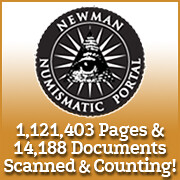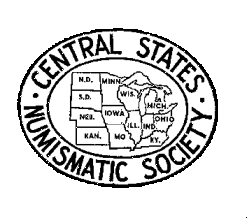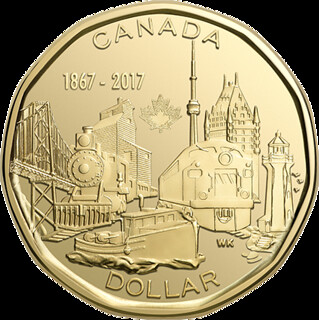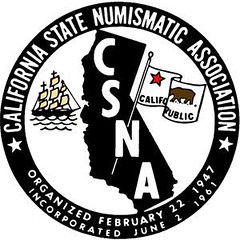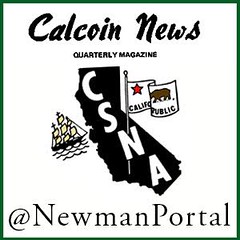
About UsThe Numismatic Bibliomania Society is a non-profit organization devoted to the study and enjoyment of numismatic literature. For more information please see our web site at coinbooks.org SubscriptionsThose wishing to become new E-Sylum subscribers (or wishing to Unsubscribe) can go to the following web page link MembershipThere is a membership application available on the web site Membership Application To join, print the application and return it with your check to the address printed on the application. Print/Digital membership is $40 to addresses in the U.S., and $60 elsewhere. A digital-only membership is available for $25. For those without web access, write to: Terry White, Treasurer
AsylumFor Asylum mailing address changes and other membership questions, contact Terry at this email address: terrywhite5475@yahoo.com SubmissionsTo submit items for publication in The E-Sylum, just Reply to this message, or write to the Editor at this address: whomren@gmail.com BUY THE BOOK BEFORE THE COINSale Calendar |
- WAYNE'S WORDS: THE E-SYLUM JULY 16, 2017
- THE 2017 NBS BENEFIT AUCTION
- NEW BOOK: 100 GREATEST U.S. MODERN COINS, 4TH ED.
- NEW BOOK: GOLD COINS OF NEWFOUNDLAND
- BOOK REVIEW: FORGOTTEN COLORADO SILVER
- RCNA OFFERS WRITER AND EDITOR SEMINAR
- CENTRAL STATES AUTHOR GRANT APPLICATIONS
- ARRESTS MADE IN THEFT OF BIG MAPLE LEAF
- NEWMAN PORTAL ADDS WIENER CORRESPONDENCE
- HARPER: VIDEO CAPTURES NUMISMATIC HISTORY
- MORE ON SALMON CHASE BANKNOTE PEDIGREES
- NOTES FROM E-SYLUM READERS: JULY 16, 2017
- NUMISMATIC CONSERVATION SERVICE TACKLES LUCITE
- JEFF SHEVLIN JOINS NORTHERN NEVADA COIN
- VOCABULARY TERM: ENGRAVERS' BALL
- LUTHER HERBERT WHITT (1903-1977)
- DISPOSING OF THE LILLY COLLECTION
- FAUNA: WILD ANIMAL ELONGATED CENTS
- PENNYBANDZ: WEAR YOUR SOUVENIR ELONGATED CENT
- NUMISMATIC NUGGETS: JULY 16, 2017
- KELLEN HOARD'S 2017 ANA SUMMER SEMINAR REPORT
- WAYNE'S NUMISMATIC DIARY: JULY 16, 2017
- CRIME WINE: COUNTERFEITING THE COPPER COIN
- MORE ON THE VICTOR ADDA COLLECTION
- ROMAN COIN HOARD AT SPANISH MINING SITE
- MEDIEVAL TALLY STICKS AND HOW THEY WORKED
- COIN CELEBRATES ORDER OF CANADA MEDAL
- CANADIAN DOLLAR DESIGNER KLASSEN MEETS PUBLIC
- UK AQUATICS OLYMPIC 50P SETS PRICE RECORD
- ISLAMIC STATE CURRENCY DESIGNER REPORTED KILLED
- SHILLING BANKNOTE CENTER OF SOMALI CONFLICT
- THE DAY KENYANS DUG OUT THEIR CASH
- MUSEUM OF THE RIVERINA EXHIBIT EXAMINES MONEY
- VISA LURES MERCHANTS TO GO CASHLESS
Click here to access the complete archive
To comment or submit articles, reply to whomren@gmail.com
Content presented in The E-Sylum is not necessarily researched or independently fact-checked, and views expressed do not necessarily represent those of the Numismatic Bibliomania Society.
WAYNE'S WORDS: THE E-SYLUM JULY 16, 2017
 New subscribers this week include: Steve Trandem and Ed Waddell. Welcome aboard! We now have 3,254 subscribers. Thanks to Shanna Schmidt for mentioning us in her Newsletter #25 earlier
today. Shanna is also a contributor to our print journal, The Asylum.
New subscribers this week include: Steve Trandem and Ed Waddell. Welcome aboard! We now have 3,254 subscribers. Thanks to Shanna Schmidt for mentioning us in her Newsletter #25 earlier
today. Shanna is also a contributor to our print journal, The Asylum.
Thank you for reading The E-Sylum. If you enjoy it, please send me the email addresses of friends you think may enjoy it as well and I'll send them a subscription with your compliments. Contact me at whomren@gmail.com anytime regarding your subscription, or questions, comments or suggestions about our content.
This week we open with the 2017 NBS Benefit Auction, two new books and one review. Other topics this week include the Royal Canadian Numismatic Association convention, a writer's seminar, author grants, elongated cents, extracting coins from Lucite, dealer Luther Whitt, the Hoover boys, and tally sticks.
To learn more about the gold coins of Newfoundland, fandango dollars, Lesher's dies, engraver's balls, the Big Maple Leaf theft arrests, the Adams Academy medal, the Ferracute dogs medal, and the Ethiopian Birr, read on. Have a great week, everyone!
Wayne Homren
Editor, The E-Sylum
THE 2017 NBS BENEFIT AUCTION
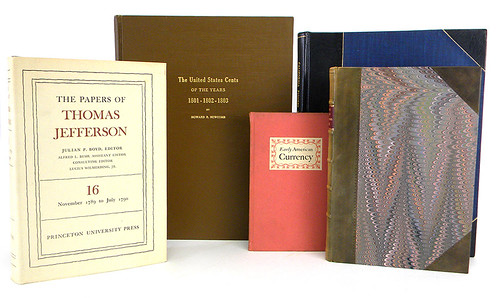
Each year at the ANA World’s Fair of Money, the Numismatic Bibliomania Society conducts a benefit auction to raise funds for the organization. All items sold are donated to the NBS by members and 100% of the proceeds go to the NBS treasury.
This year, we are trying to increase participation in the auction by distributing a catalogue of the sale to all NBS members so that members unable to attend in person can participate.
Absentee bids should be sent to David Fanning at df@numislit.com by the end of Thursday, August 3. The sale will take place on Friday, August 4 as part of the NBS General Meeting, to be held in Room 112 of the Colorado Convention Center from 11:30 a.m. to 1:30 p.m. Please read the terms of sale before bidding.
You can download a PDF of the catalogue here:
http://www.coinbooks.org/NBS%20Auction%202017.pdf

NEW BOOK: 100 GREATEST U.S. MODERN COINS, 4TH ED.
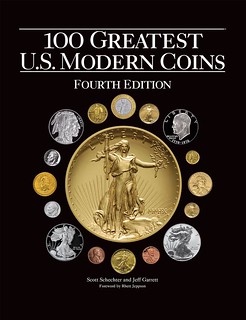 The fourth edition of Whitman Publishing’s 100 Greatest U.S. Modern Coins will enjoy its public debut in a few short weeks. Look for it at the American Numismatic Association World’s
Fair of Money in Denver, Colorado. In the meantime, if you’re a fan of modern U.S. coins, you can preorder your copy online or from your favorite local bookstore.
The fourth edition of Whitman Publishing’s 100 Greatest U.S. Modern Coins will enjoy its public debut in a few short weeks. Look for it at the American Numismatic Association World’s
Fair of Money in Denver, Colorado. In the meantime, if you’re a fan of modern U.S. coins, you can preorder your copy online or from your favorite local bookstore.
When 100 Greatest U.S. Modern Coins debuted in February 2011, it was the eighth volume in Whitman Publishing’s popular 100 Greatest™ library of books. In earlier volumes the spotlight was occupied by rare and valuable ancient coins, unique eighteenth- and nineteenth-century U.S. classics, and even unusual and visually astounding error coins and misstrikes. Finally it was time to focus on the lively field of modern coins, from circulating nickels and quarters to silver and gold commemoratives, Proofs, bullion coins, and more.
This exciting category makes up an impressively large share of today’s numismatic market. Fans of “moderns” are among the most active and enthusiastic collectors in the hobby. To give just one example: The American Eagle bullion-coin program has been part of the numismatic landscape for a little over 30 years. In that time, collectors and investors have purchased more than 400 million American Silver Eagles, plus tens of millions of their gold and platinum cousins. If a book sold that many copies, it would be a runaway best-seller! (Readers have bought about 100 million copies of J.R.R. Tolkien’s The Hobbit since it was first published; J.K. Rowling’s wildly popular Harry Potter books enjoy print runs in the tens of millions each.) Visit any of the online hobby forums and you’ll find countless threads and conversations revolving around the U.S. Mint’s latest commemorative coins, medals, and bullion pieces. “Collectors love their Morgan dollars and Saint-Gaudens double eagles,” says Diana Plattner, editor of Coin Update (www.coinupdate.com) and Mint News Blog (www.mintnewsblog.com). “But a feature article on the newest U.S. Mint release is guaranteed to bring hundreds of spirited comments, questions, and strong opinions.”
My own appreciation of the complexity and appeal of modern coins has increased in recent years. In 2016 I was appointed to membership in the Citizens Coinage Advisory Committee (www.CCAC.gov), a public panel that advises the secretary of the Treasury on the designs and themes of U.S. coins. Serving on the committee has been an eye-opening experience. It has rounded out my education in the entire process of modern coin creation.
Many collectors misunderstand the origin of modern coins such as commemoratives, National Park quarters, and Presidential dollars. While the Treasury Department does have authority to create certain limited coinage programs (e.g., special gold pieces such as the 2009 Ultra High Relief and the more recent high-relief American Liberty coins), nearly all of its products are mandated by Congress and signed into existence by the president. Congress decides the overarching themes, gives authority, and sets parameters.
“Congress orders, and the Mint executes,” is what one Mint officer has told me.
The CCAC has 11 members, each of us either representing the general public or specially qualified in a particular field (sculpture or the medallic arts; numismatic curatorship; American history; and numismatics). We are “an informed, experienced, and impartial resource to the secretary of the Treasury and represent the interests of American citizens and collectors.” For each coinage program we confer early in the process, meeting with stakeholders to flesh out basic design ideas to guide the Mint’s artists; then, weeks or months later, we meet to review and analyze the sketches the artists developed. Every design is considered seriously—even when there are 60 or more to review in a single portfolio!
How does modern coinage not work? It’s not “design by committee.” It’s not a lone bureaucrat sitting in an office making up programs. If you think the Mint is producing too many military-themed commemoratives, write to your congressman. If you think a palladium bullion coin is a good idea, or want to see your favorite charity honored with a silver dollar, or have an idea for a new circulating quarter dollar program, remember that “Congress orders, and the Mint executes.” Every new coin starts with an idea, which grows (with a lot of legwork) into legislation at the congressional level (or program management if initiated within the Treasury Department), then moves into concept development, then to design sketches, then review by the CCAC (and also the U.S. Commission of Fine Arts), which results in formal recommendations sent to the Treasury secretary. The secretary makes the final decision on all coin designs.
After a new coin is finally minted, it belongs to history and it’s there for the hobby community to enjoy, critique, collect, and study.
It’s in the latter pursuit that authors Scott Schechter and Jeff Garrett are uniquely positioned when it comes to the 100 Greatest U.S. Modern Coins. Each has collected coins since childhood; each has years of unique hands-on experience as a professional numismatist, including buying and selling moderns. Schechter is vice president and finalizer at Numismatic Guaranty Corporation (NGC); his first official job in numismatics was in 1994, when he interned at the Smithsonian Institution, working with the National Numismatic Collection. Garrett is a longtime coin dealer and active promoter of the hobby, this year finishing up his term as president of the American Numismatic Association.
In their engaging and informative book Schechter and Garrett share insight on many behind-the-scenes numismatic situations. As you read you’ll find yourself thinking, “So that’s why this coin was made!” or “That explains why that coin is so rare.” There are as many mysteries, stories, and busted myths within modern coins as there are in any of the classic series.
The fact that 100 Greatest U.S. Modern Coins is already in its fourth edition attests to the coins’ evergreen appeal and popularity. If you haven’t yet been bitten by the modern-coin bug, you will be after enjoying this entertaining volume. Along the way you’ll learn a lot about our nation and its remarkable coinage.
100 Greatest U.S. Modern Coins
By Scott Schechter and Jeff Garrett; foreword by Rhett Jeppson
ISBN 0794845231
Hardcover, coffee-table size
144 pages
Full color
Retail $29.95 U.S.
NEW BOOK: GOLD COINS OF NEWFOUNDLAND
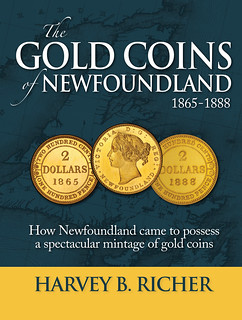 The Gold Coins of Newfoundland 1865-1888 - Harvey B. Richer
The Gold Coins of Newfoundland 1865-1888 - Harvey B. Richer
Newfoundland was the only British colony in North America to strike gold coins for general circulation. This was remarkable given that it was one of the poorest British possessions in North America and with an economy largely based on the barter system. This book explores the history of Newfoundland through its coinage. It presents fascinating new details for each year that gold coins were minted, the existing distribution of these scarce coins, a survey of the greatest collections ever assembled, and the provenances of the rarest of the gold coins.
For more information, or to order, see:
The Gold Coins of Newfoundland 1865-1888 - Harvey B. Richer
(http://www.downhomedistribution.com/The-Gold-Coins-of-Newfoundland-1865-1888--Harvey-B-Richer_p_2156.html)
 After spending time sitting behind some of the world’s largest telescopes — including having time allotted on NASA’s Hubble Space Telescope — and peering into the heavens, you wouldn’t
think Canadian astronomer Harvey Richer would have much interest in a little down-to-earth pocket change from Newfoundland’s past.
After spending time sitting behind some of the world’s largest telescopes — including having time allotted on NASA’s Hubble Space Telescope — and peering into the heavens, you wouldn’t
think Canadian astronomer Harvey Richer would have much interest in a little down-to-earth pocket change from Newfoundland’s past.
But just as the mystery of the origin of the universe draws his gaze upward, a fascinating period in Newfoundland’s coinage history ignites his interest on the ground.
Richer is a professor of astronomy and physics at the University of British Columbia and a collector of old coins on the side. His interest in old coinage began in childhood with the purchase of some rare Newfoundland gold coins. As the years passed he became determined to find out why Newfoundland gold coins were minted only during some of the years between 1865 and 1888.
Now Richer has written a book, “The Gold Coins of Newfoundland, 1865-1888: How Newfoundland came to possess a spectacular mintage of gold coins.”
The book is published by Boulder Publications with its Newfoundland launch set for Thursday, July 27 from 5-7 p.m. at the Anna Templeton Centre on Duckworth Street in St. John’s.
In the prologue of his book, Richer states the numismatic history of Newfoundland is different from that of the other provinces, mainly because it did not join Confederation until 1949.
“Like the other provinces-to-be, it began producing (at the Royal Mint in the United Kingdom) its own coinage in the early 1860s, but since it would not join Confederation for another 85 years, it came to have a much richer and more extensive coinage history than any of the other British colonies, producing coins up to 1947,” he writes.
“Not only did Newfoundland, like other provinces, request from London bronze and silver coins but in eight non-consecutive years between 1865 and 1888, it asked London for a supply of gold coins. It is apparent from the documents discussed in this book that these requests were always granted. This is remarkable because Newfoundland was the poorest of the British colonies in North America in the 1860s, and significantly less wealthy than virtually any other locale on the continent at that time.”
“One day we lifted up a rock and we found a big one cent piece and it had a picture of Queen Victoria. Of course, we didn’t know it was Queen Victoria at the time, and it was dated 1890. We took it to a local coin shop and the owner taught us about this coin and other coins. It turned out this coin was a large cent of Canada they minted until 1920, it started in 1858.”
Some time later, noted Richer, the coin shop owner called him and said he had some Newfoundland gold coins he was selling and wanted to know if he was interested.
“I put all the money I had in the world together and I bought two. I think they were $20 each,” he said. “Ever since that time I’ve had a love of Newfoundland coins.”
Richer now has a collection of the old Newfoundland gold coins.
Richer said for the last 50 or 60 years he’s kept the idea of preparing a book about the Newfoundland gold coins in the back of his mind. In 2013, he said, he finally visited the province along with his son and that trip set the book in motion.
“If I hadn’t visited Newfoundland I probably wouldn’t have written the book,” he said. “It’s such an incredible place. It has such a rich history and I think it is absolutely gorgeous. After that trip I started writing the book which took me four years. The book was a labour of love engendered by the first trip to Newfoundland which just blew me away.”
In the book, there are two key questions explored: Why did Newfoundland, then a colony of Great Britain, request gold coinage and why did Britain agree to it? And why were no gold coins minted after 1888?
Research for the book included digging through archives, collecting documents and reviewing microfilm of old newspapers in Newfoundland and London.
Richer said striking gold coins for general circulation at the time was remarkable given that, not only was Newfoundland one of the poorest of the British colonies, but its economy was largely based on the barter system.
The book, he said, explores the history of Newfoundland through its coinage. It also discusses the existing distribution of the scarce coins.
To read the complete article, see:
Canadian astronomer, avid coin collector pens book on rare Newfoundland
gold coins (http://www.thetelegram.com/living/2017/7/14/canadian-astronomer--avid-coin-collector-writes-book-on-rare-new.html)

BOOK REVIEW: FORGOTTEN COLORADO SILVER
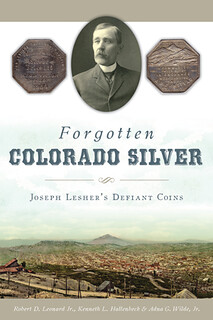 Forgotten Colorado Silver “Joseph Lesher’s Defiant Coins,” Authors: Robert D. Leonard Jr., Kenneth L. Hallenbeck & Adna G. Wilde, Jr., The History Press, Charleston, SC, 2017.
Forgotten Colorado Silver “Joseph Lesher’s Defiant Coins,” Authors: Robert D. Leonard Jr., Kenneth L. Hallenbeck & Adna G. Wilde, Jr., The History Press, Charleston, SC, 2017.
Reviewed by John and Nancy Wilson, NLG
Forgotten Colorado Silver, “Joseph Lesher’s Defiant Coins,” was authored by Robert D. Leonard Jr., Kenneth L. Hallenbeck & Adna G. Wilde, Jr. It was published by The History Press, Charleston, SC, in 2017 with 126 pages, black and white photos and is softbound. Mr. Leonard has been studying Lesher Dollars since the 1960s. The reference is an in-depth study of Lesher Dollars and the issuers who used them in every day commerce. The authors say the person most responsible for seeing this new, authoritative account of the Lesher Dollars through to completion is Robert S. Kincaid. Mr. Wilde’s research on the subject was used extensively.
The Cripple Creek mining district, covered in the first chapter, told how the town got its name in the 1870s. Robert Womack was the first to discover gold in Cripple Creek and a photo of him is shown. The amounts of gold and silver produced in the city is given. There is a discussion about how the Constitution gives Congress the power to coin money and regulate its value. In 1830 Templeton Reid tested the government monopoly on coining money. His mint, which eventually failed, was soon followed by other mints mostly in the Western states. Also discussed was President Cleveland repealing the Sherman Act, and William Jennings Bryan's advocacy for free silver.
Free Silver advocate Joseph Lesher was a pioneer, promoter and minter who was born on July 12, 1838 and passed away in Victor, CO, on the 4th of July in 1918. His early life is covered from his birth in Ohio, military service, and his move to Colorado in 1865 and his opening a mine near Central, CO., and his interests in others. His occupation was listed in the records as being in real estate, though his diversified interests included an ice cream stand in Mound City.
Between 1900 and 1903, he worked with the “Referendum Dollar scheme.” They even had government bureaucracy back in his days. He moved to Nevada to prospect for silver in 1906 and his mine was found to have 5000 ounces of silver to the ton, but he never took advantage of it. He was still prospecting at the age of 75. His great financial problems began in 1914 and when he died in 1918 his wife wrote the Bureau of Pensions saying that she didn’t have enough money for his funeral services. Mrs. Lesher sent a letter to F. Zerbe in 1934 stating that, no one took him to be over 65 years old and his hair was not grey.
With the repeal of the Sherman Act in 1893, Lesher “decided that if the Treasury wouldn’t buy any more silver to coin into dollars, then he would.” By 1900 his “Referendum Dollar,” came into fruition and Joseph Lesher became more than a footnote in history.
After the repeal of the Sherman Act in 1893 and as a result, the price of silver dropping, Colorado was devastated. The Colorado Governor in 1893 wanted the state to buy silver, and send it to Mexico to be coined into dollars, returned to the state and placed into circulation. His colleagues in the legislature didn’t like the idea and called them “fandango dollars.”
Joseph Lesher came on the scene in 1900 and
“The Lesher Referendum Dollar was soon minted; though the 1864 Act forbade silver coinage of any kind. Also described are the trials and tribulations of minting the Lesher Dollars, the sale of them, many newspaper articles, the patents and designs. He was able to foil all the efforts of the Secret Service to shut him down. No Lesher Dollars were ever seized; all that he lost was his first set of dies.”
The authors did a masterful job of compiling in one place all the known information on the issuers of the dollars. They also went the extra mile in bringing new and valuable information on the subject. Several chapters in the reference cover everything regarding the issuers' involvement with the Lesher Referendum Dollars starting with the A. B. Bumstead issues, other types followed by J. M. Slusher, Sam Cohen, D. Q. Klein & Co., Geo. Mullen, Boyd Park, W. C. Alexander, Goodspeed & Co., J. E. Nelson & Co., W. F. White Merc. Co, H. Stein, H. H. Rosser and A. W. Clark. The authors give known census and research figures but do not give exact rarities (R-1 to R-10), which constantly change. The authors do have estimates of original mintage in every case.
Farran Zerbe was among the earliest to research and collect Lesher Dollars, which were catalogued in the American Journal of Numismatics in 1917 and listed by Zerbe numbers. Lesher dollar dies are listed by Zerbe number. The mintages mentioned by Lesher in 1913 were between 2000 to 3000. The following year Zerbe was told by Lesher that 3500 were struck and Zerbe concluded that about 3000 pieces were struck. In 1978 Wilde knew of just 384 pieces, but as of the date of this writing the total is now about 600. It might be impossible to obtain a complete type set at present. However, a set of one of each major type--Zerbe 1, inscription only, Zerbe 2 or 3--Bumstead type, and an Imprint type of any issuers, is certainly possible.
This is the most comprehensive listing of the issuers ever written. The Bibliography gives you the sources of information for this reference. In summary the book is great for both the collector and non-collector of Lesher dollars.
For information on obtaining this reference, it is listed at $21.99 and can be purchased from Arcadia Publishing, 420 Wando Park Boulevard, Mt. Pleasant, SC 29464 – www.arcadiapublishing.com. Also at these locations: Amazon.com, BarnesandNoble.com, Books-A-Million, or any bookstore. Right now, Amazon has it at $17.22 + shipping (free for Prime subscribers).
One problem with the book is the photos of the Lesher dollars themselves - they are smaller and darker than one would expect. Author Leonard was disappointed with the final product, which didn't meet his expectations from the galleys he'd seen. Nevertheless, this long-awaited book is a tremendous addition to the hobby, and given its low price there is no reason why anyone with the slightest interest in U.S. numismatics shouldn't get themselves a copy. -Editor
To read the earlier E-Sylum article, see:
NEW BOOK: FORGOTTEN COLORADO SILVER (http://www.coinbooks.org/v20/esylum_v20n25a03.html)

RCNA OFFERS WRITER AND EDITOR SEMINAR
 We’re only one week away from this year’s Royal Canadian Numismatic Association (RCNA) Convention, which will be taking over Boucherville, Qué. from July 18-23.
We’re only one week away from this year’s Royal Canadian Numismatic Association (RCNA) Convention, which will be taking over Boucherville, Qué. from July 18-23.
The convention is being organized by host club l’Association des Numismates et des Philatélistes de Boucherville (ANPB), which has previously organized the RCNA’s annual gathering in Montréal in 1992 and 1996. This year’s show is being held at Hôtel Mortagne on 1228 Nobel St. in Boucherville, which is just east of Montréal on the south shore of the St. Lawrence River.
The bourse and exhibit hall will be open to the public on July 21 from 10 a.m.-6 p.m.; July 22 from 10 a.m.-6 p.m.; July 23 from 9 a.m.-2 p.m. In addition to more than 60 dealer tables, the convention will also boast an extensive auction, a vast offering of competitive exhibits, an educational symposium and a variety of meetings, presentations and social gatherings throughout the six-day event.
CANEW SEMINAR
If you’re a writer, or if you’re at all interested in writing, one of the highlights of the convention will be the Canadian Association of Numismatic Editors and Writers (CANEW) seminar. During its
July 22 meeting, CANEW will offer a bilingual seminar exploring the various tools that are available to writers and editors to improve their craft or “simply to make their lives easier,” according to
organizers. CANEW was formed last year to facilitate the sharing of knowledge between its members. Award-winning writers and editors who are members of CANEW are also willing to mentor newcomers to
this area of the hobby.
For more information about CANEW, contact Serge Pelletier at pelletier@canew.club.
To read the complete article, see:
Bilingual seminar for writers, editors to be offered at upcoming RCNA Convention
(http://canadiancoinnews.com/first-training-kind-offered-upcoming-rcna-convention/)
CENTRAL STATES AUTHOR GRANT APPLICATIONS
The window to apply for a Central States author grant is July 1 through August 31. That grants are for a maximum of $5000. Interested individuals should email Ray Lockwood CSNS Education Director for applications and additional information.
For more information on CSNS, see:
http://www.centralstates.info/
To read earlier E-Sylum articles, see:
CENTRAL STATES AUTHOR GRANT APPLICATION DEADLINE AUGUST 31, 2013 (http://www.coinbooks.org/esylum_v16n30a09.html)
2014 CENTRAL STATES AUTHOR GRANTS ANNOUNCED (http://www.coinbooks.org/esylum_v16n42a08.html)
CENTRAL STATES AUTHOR GRANTS (http://www.coinbooks.org/esylum_v18n32a13.html)
CENTRAL STATES AWARDS 2016-2017 AUTHOR GRANTS (http://www.coinbooks.org/esylum_v19n41a04.html)

ARRESTS MADE IN THEFT OF BIG MAPLE LEAF
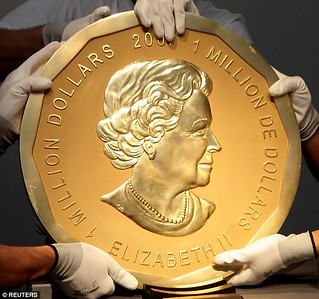 Several people have been arrested in Berlin in connection with the spectacular heist in March of a 100-kilo gold coin from a museum in the city. The "Big Maple Leaf" is estimated
to be worth several million euros.
Several people have been arrested in Berlin in connection with the spectacular heist in March of a 100-kilo gold coin from a museum in the city. The "Big Maple Leaf" is estimated
to be worth several million euros.
Berlin police launched raids on multiple locations in the city on Wednesday, deploying a SWAT team and making several arrests linked to the spectacular robbery on the Bode museum in March. While authorities confirmed that arrests had been made, they did not provide any details on the suspects.
The majority of the raided homes were in the district of Neukölln, an area with a large immigrant population, a police spokesman said. However, there was still "no decisive information" on the location of the coin.
Police had previously speculated that the 100-kilogram (221 pound) coin could have been melted away and divided into smaller chunks.
As DW reported in late March, the group of thieves likely broke into Berlin's Bode Museum from an elevated section of tram tracks which run alongside the museum walls. Security footage from a nearby stop shows three masked perpetrators. They allegedly placed a ladder on the tracks to reach a window and gain entry to the building. They then smashed the glass display case and rolled the 53-centimeter (21-inch) coin outside.
According to the investigators, the thieves then loaded the coin into a wheelbarrow and wheeled it across a railway bridge to the other side of the river Spree. They then climbed off the tracks on a rope and loaded the coin into a car.
The investigators found a deep impact mark below the tracks, suggesting that the coin was dropped and likely damaged. The police also found the rope, the ladder and the wheelbarrow as well a burning Mercedes in an underground car park.
To read the complete article, see:
Berlin police make arrests over giant gold coin theft
(http://www.dw.com/en/berlin-police-make-arrests-over-giant-gold-coin-theft/a-39651466)
A spokesperson confirmed newspaper reports that the suspects arrested at two properties in the Neukölln district were members of an “Arabic-Kurdish clan” known to investigators in connection with drug smuggling, arms trading and racketeering.
The Berlin state office of criminal investigations tracked down the suspects through DNA evidence.
With a diameter of 53cm and 3cm thick, the Big Maple Leaf coin is one of only five pure gold commemorative pieces issued by the Royal Canadian Mint in 2007.
Its whereabouts remains unclear. Police suspect the robbers may have melted the coin down at the earliest opportunity.
“The trick used by such criminals is that they add, for example, a little bit of copper to the molten gold in order to change the purity levels and cover their tracks,” an investigator told Die Welt newspaper.
Howard adds:
Pictured on the back of my book is the same coin when it was in the museum in Vienna.

To read the complete article, see:
German police make arrests over €4m gold coin heist
(https://www.theguardian.com/world/2017/jul/12/german-police-make-arrests-over-4m-gold-coin-heist)
To read the earlier E-Sylum articles, see:
POLICE RELEASE VIDEO OF BIG MAPLE LEAF THIEVES (http://www.coinbooks.org/v20/esylum_v20n28a14.html)
NEW BOOK: THE NUMISMATOURIST (http://www.coinbooks.org/esylum_v17n31a03.html)
To read the complete articles, see:
Arrests made in heist of massive $1M gold Canadian coin (http://www.cbc.ca/news/world/coin-heist-arrest-1.4200761)
How Berlin's Lebanese mafia clans work
(http://www.dw.com/en/how-berlins-lebanese-mafia-clans-work/a-39679398)
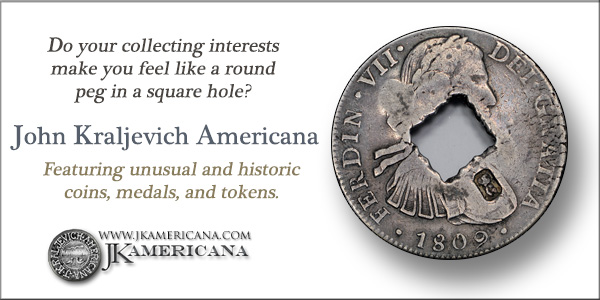
NEWMAN PORTAL ADDS WIENER CORRESPONDENCE
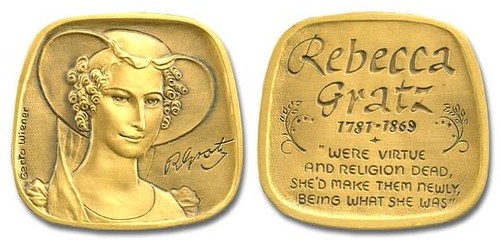
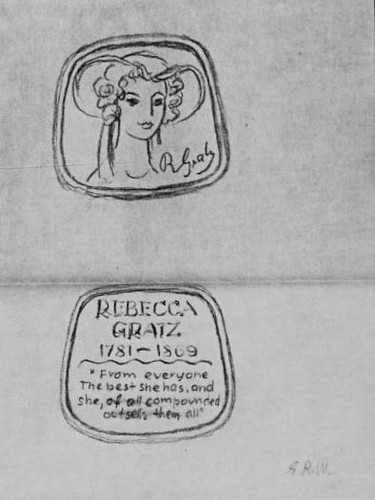 Gerta Ries Wiener (1898-2000) was an American medalist known for her series of medals commissioned by the Jewish-American Hall of Fame. These portrayed a number of Jewish figures including
Louis Brandeis, Gertrude Stein, Golda Meir, and others. For many years (1970-1996), Wiener maintained an active correspondence with Mel Wacks, Director of the Jewish-American Hall of Fame Division of
the American Jewish Historical Society. This correspondence discusses the creative process behind the medals and includes many sketches and illustrations. Wacks contributed his copy of this file (the
originals are in the Smithsonian), and this material is now available on the Newman Portal.
Gerta Ries Wiener (1898-2000) was an American medalist known for her series of medals commissioned by the Jewish-American Hall of Fame. These portrayed a number of Jewish figures including
Louis Brandeis, Gertrude Stein, Golda Meir, and others. For many years (1970-1996), Wiener maintained an active correspondence with Mel Wacks, Director of the Jewish-American Hall of Fame Division of
the American Jewish Historical Society. This correspondence discusses the creative process behind the medals and includes many sketches and illustrations. Wacks contributed his copy of this file (the
originals are in the Smithsonian), and this material is now available on the Newman Portal.
Shown here are the artist’s conception and final engraving of the Rebecca Gratz medal, issued in 1981. Gratz was a Philadelphia philanthropist, and one with numismatic connections – she was a sister of Simon Gratz, likely the same whose collection was sold by Philadelphia dealer Edward Cogan in May 1859.
Link to Wiener/Wacks correspondence on Newman Portal:
https://nnp.wustl.edu/library/archivedetail/520609
Link to Cogan/Gratz catalog on Newman Portal:
https://nnp.wustl.edu/library/auctionlots?AucCoId=19&AuctionId=510461
HARPER: VIDEO CAPTURES NUMISMATIC HISTORY
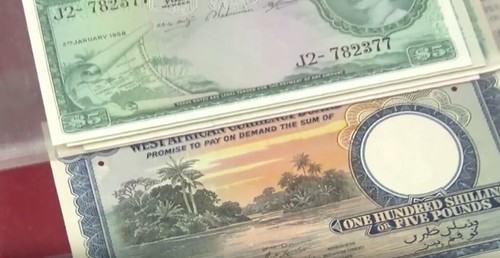
I was a regular attendee at the International Paper Money Shows in Memphis, Tenn., for many years.
It moved this year to Kansas City, Mo.
I was unable to be there, June 8-11, but fortunately David Lisot was.
He recorded some of the event.
He emailed me the result.
I checked out show owner Lyn Knight on Lisot’s video.
Take a look at it.
Not only does it make me regret my inability to attend, but it makes me think about the future.
Lisot’s work will be the single biggest video record of the last three decades of numismatic activity.
He was recording events before the Internet was available to the public.
In the future, this video record will probably be used as primary resource material to illustrate the condition of the numismatic hobby/business in the late 20th century and in the early 21st century.

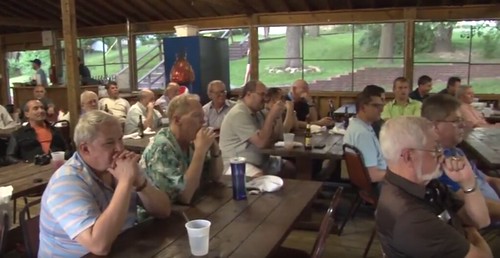
If there had been someone to record the bourses of the early 1960s, collectors today would note how cool everyone looked in their narrow ties and lapels.
Why it looks just like 2017 – well, maybe not.
We wear suits much less often than we used to.
Will people still know what paper money even is in 2067?
Or will they be sending images of bank notes to each other with messages that if you remember these, you must really be old.
To read the complete article, see:
Lisot videos show us who we are (http://www.numismaticnews.net/buzz/lisot-videos-show-us)
To watch the video, see:
CoinTelevision: International Paper Money Show Attracts World Bank Note Collectors. VIDEO: 3:48
(https://www.youtube.com/watch?v=qexUws-AFvQ&feature=youtu.be)

MORE ON SALMON CHASE BANKNOTE PEDIGREES
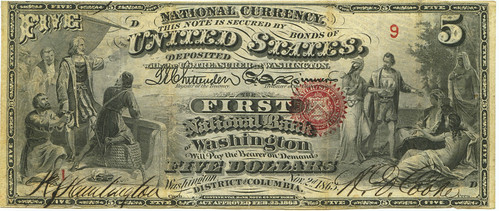
The very first $5 Original Series National Bank Note
Julian Leidman writes:
I know that Phil Lampkin owned this note and may have purchased it at the Sotheby sale. I believe that his daughter sold it after his death to Marc Watts of Gaithersburg Coin Exchange and I think that Mark Hotz may have it currently.
To read the earlier E-Sylum article, see:
1970 SOTHEBY SALES SOUGHT FOR CHASE PEDIGREE (http://www.coinbooks.org/v20/esylum_v20n28a13.html)
NOTES FROM E-SYLUM READERS: JULY 16, 2017
Mystery Coin Found in Seattle
Web site visitor Phil Hoover writes:
I found this coin metal detecting in Seattle WA on a sidewalk, so who knows the back story on how it ended up there. I really have no idea what it is.
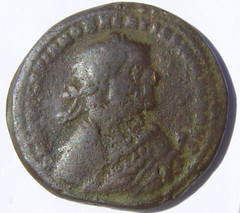
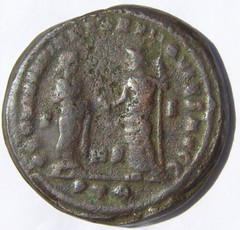
Query: Identical Serial Number $1 Bills
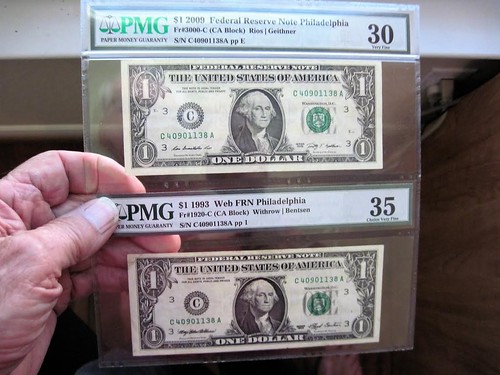
Bill Sponseller of Houston, Texas writes:
I understand how you might be able to match up same serial number pairs of dollar bills, including with the same prefix and suffix letters, if they have fancy serial numbers, since fancy numbers are saved as collectibles. But how about matching up a pair with a random number, one that you take out of your pocket. I have 2 one dollar bills with same number C40901138A, series 1993 and 2009. I can see nothing whatsoever that is special about this number that would catch any ones attention. They are graded 30 and 35 by PMG, meaning they were not saved from new, but pulled from circulation, and around 16 years apart?
The number of one dollar bills printed for each series for all Federal Reserve Banks varies, but an average of about 10 billion is close enough. This means if you pulled a random serial number dollar bill out of your pocket, the odds of finding an exact numbers-letters match for that bill would be about 1 in 10 billion. In other words, if you looked through 1,000,000 bills your odds of finding an exact match in those one million bills would be 1 in 10,000.
I got them in an eBay auction. The seller does not know how they got matched up, and the same goes for the person he got them from. Who would ever want to spend even 10 minutes of their time looking for such a match?
Can you think of any plausible idea of how this might have happened?
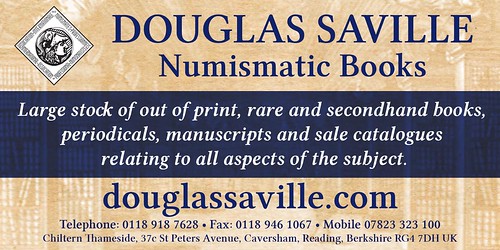
NUMISMATIC CONSERVATION SERVICE TACKLES LUCITE
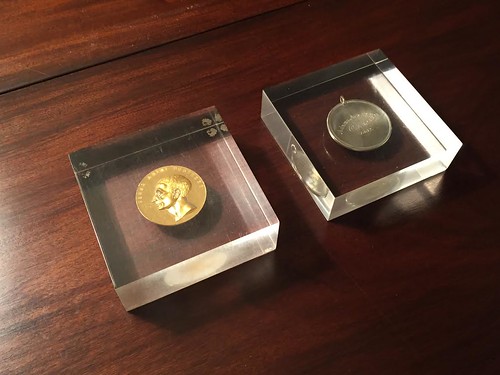
Question: Say you had a very rare gold, proof, U.S. Mint medal embedded in a block of Lucite. Would you a) try to dissolve the Lucite in one of the many solvents mentioned in previous E-Sylum posts (glacial acetic acid, acetone) or online (dichloromethane, chloroform), b) try to freeze it in liquid nitrogen until it cracks, which has also been mentioned, and/or c) take a hammer to it (also mentioned at one point in The E-Sylum)?
Answer: None of the above. You would send the medal to NGC’s Numismatic Conservation Service, wait for a couple months while they use their proprietary magic, and then smile broadly when the medal comes back as if it had never been entombed!
A few months ago I had the opportunity to acquire a very rare gold Adams Academy medal, which was struck by the U.S. Mint in the late-19th century, and is listed as Julian SC-1. It was one of a total 17 struck and only the second example to make it onto the market, the first being the example that Jonathan Brecher bought on eBay about 10 years ago (for $65!). This second example came with an engraved silver running award to the same recipient, but unfortunately, both were embedded in Lucite blocks. Jonathan also discovered this second Adams Academy piece and we worked out a trade for an equally rare, gold U.S. Mint medal – more on that below.
After reading the many earlier E-Sylum entries on Lucite removals and doing some online research on the underlying chemistry and possible solvents, I tracked down a technical service engineer at Mitsubishi Chemical, which had acquired the Lucite business in 2009. He felt that it would be very difficult to remove anything cleanly from Lucite and suggested I simply take a hammer to it. Hmmm…gold, proof…seemed risky. And my wife wasn’t too keen on having any of the various possible chemical solvents in the house, especially chloroform. So, I contacted Danielle Caffrey and Dave Camire, the head of NCS, and decided to send them both medals.

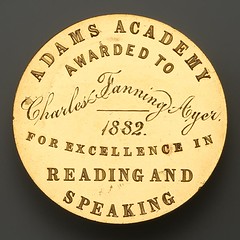
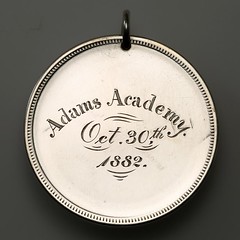

As you can see from the photos, both the gold and silver medals came out great. Even if I knew what specific solvents and processes they used, I would still recommend using NCS for anything valuable, as they know what they are doing.
The trade, by the way, involved a handful of medals, but fundamentally boiled down to this rare Adams Academy medal for an equally rare, gold Boston Latin School Derby Medal (Julian SC-10), also struck by the U.S. Mint. Jonathan had had to pay a bit more for his second example, around $150 he said (!), but as I had acquired my two Derby medals on eBay for $41 and $210 some years ago, and there are no modern sale records for either of these rare medals, it seemed like a pretty fair trade.
To read the earlier E-Sylum articles, see:
EXTRACTING COINS EMBEDDED IN LUCITE (http://www.coinbooks.org/esylum_v09n03a21.html)
EXTRACTING COINS EMBEDDED IN LUCITE (http://www.coinbooks.org/esylum_v09n04a22.html)
ADAMS ACADEMY U.S. MINT MEDAL DISCOVERY (http://www.coinbooks.org/esylum_v11n03a13.html)
HOW TO EXTRACT A MEDAL FROM A BLOCK OF LUCITE (http://www.coinbooks.org/esylum_v11n21a13.html)
MORE ON REMOVING COINS AND MEDALS FROM LUCITE (http://www.coinbooks.org/esylum_v11n25a16.html)
MORE ON COINS AND MEDALS EMBEDDED IN LUCITE (http://www.coinbooks.org/esylum_v13n40a14.html)
NGC NUMISMATIC CONSERVATION SERVICES (http://www.coinbooks.org/esylum_v19n52a16.html)
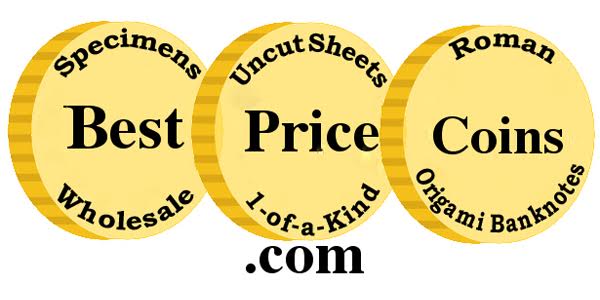
JEFF SHEVLIN JOINS NORTHERN NEVADA COIN
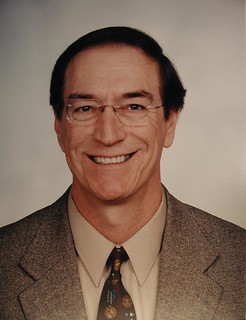 Northern Nevada Coin has hired Jeff Shevlin to manage their store in Reno, Nevada. NNC, owned by Allen Rowe has three store locations in northern Nevada, in Reno, Carson City and
Gardnerville.
Northern Nevada Coin has hired Jeff Shevlin to manage their store in Reno, Nevada. NNC, owned by Allen Rowe has three store locations in northern Nevada, in Reno, Carson City and
Gardnerville.
Rowe said “Jeff is well known and respected in the numismatic community and I am elated to have him manage our Reno location operations. His numismatic experience and management expertise makes him a perfect fit for our Reno store.”
Jeff retired five years ago from his professional career as a senior executive IT manager and as a college professor. A lifelong passionate numismatist, since his retirement he has worked professionally in the numismatic community in various capacities including the executive director of the American Numismatic Association. Jeff is an author, researcher, publisher, public speaker and nationally recognized expert on So-Called Dollars, historical U.S. commemorative medals.
“What a fantastic opportunity”, Jeff said. “This is going to be a totally new experience for me and I am enjoying the daily interaction with fellow collectors. Reno is off I-80 on the way to or from California. It is a perfect location to stop and take a break. If you are in the area, please give me a call, stop in and let’s talk coins.”
Northern Nevada Coin Reno – 1280 E. Plumb Lane, Suite C – Reno, NV 89503 – (775) 828-2646
For more information, see:
https://www.brokencc.com/
VOCABULARY TERM: ENGRAVERS' BALL

Every hand engraver uses an engravers’ ball, his most useful tool. As a vise on a swivel it provides the engraver control of the die, hub, or medal he is engraving. By shifting the pressure with his hand while he cuts with a burin or other cutting tool, the piece moves where he wants it.
Engravers' Ball, Engravers' Block. A vise to hold a die or medallic item while some form of hand work is performed on it – engraving, chasing, inscribing, proof polishing or such. In its simplest form an engravers' ball is a metal sphere with a channel cut in the top with one or more set screws on one side of the channel to lock the work against the opposite side of the channel. Sizes range from 4-inch to 12-inch spheres. They would rest on a solid leather pad, or doughnut-shaped leather ring pad, or more recently, a nylon or felt ring pad.
The spherical shape allows the ball to easily move in any direction at the engraver's demand. By such swivel action the operator could engrave in easy motions or set the work in one position. One ingenious hand engraver, Neil Hartleip, of Fairmont, Minnesota, attached his engravers ball to a potter’s wheel and thus was able to control the direction the ball turned by foot pressure on the potter’s wheel mounted below his engraver’s bench.
A leather bag filled with sand, forming a cushion, and called an ENGRAVER'S PAD was the earliest form for supporting engraving work; this was preferred by copperplate engravers for the ease of working a flat plate more so than any kind of vise that held the plate in one fixed position. Such sand bags are still used today for embossing and repoussé work.
Modern engravers' balls are chromium plated vises to hold any work 5-inches or smaller. Engravers' blocks are more precision tools than the simple ball. They have adjustable jaws
with a plate on the top of each jaw for mounting pins and dozens of attachments for holding a variety of work. The pins are notched and attachments include extension arms for locking in odd-shaped or
pieces larger than 5-inches.
CLASS 04.1
 What do those “Class numbers” mean?
What do those “Class numbers” mean?
At the end of every entry in this Encyclopedia is the word CLASS followed by two figures, a period, and one or two figures. In compiling this work I discovered entries are related to other entries. In fact I learned the entire list can be divided into 14 groups of related terms. I numbered these from 01 to 14:
01 -- Physical Forms
02 -- Design
03 -- Sculpture, Modeling, Signatures, Editing
04 -- Engraving, Diemaking, Proving
05 -- Composition, Media
06 -- Blanking, Upsetting, Striking, Coining
07 -- Casting, Electroforming, Repoussé, Etching
08 -- Metalworking, Heat Treating, Trimming, Chasing
09 -- Finish, Finishing, Plating, Patinas
10 -- Edge Lettering, Inscribing, Mounting, Packaging
11 -- Cataloging, Describing, Curating, Preservation
12 -- Mints, Medal Manufacturing & Issuing
13 -- Collecting and Collectors' Terms
14 -- Not Elsewhere Classified
Each of these (except 01 and 14) have multiple sub-classes. In upcoming E-Sylum issues I will reveal these categories.

LUTHER HERBERT WHITT (1903-1977)
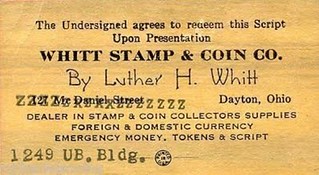 Luther Herbert Whitt (1903-1977), was born in Kentucky on July 21, 1903, the eldest child and first son of Thomas Lee Whitt (1881-1941), and Maggie Combs Whitt (1884-1914), both parents
Kentuckians. His father remarried to Maude Hall (1898-1918), when he was a teenager. At that time he worked as a farm laborer on the family farm in Wellington, Manifee, Kentucky. Being a collector
and native Kentuckian he became a life-long aficionado of Abraham Lincoln and collector of Lincolniana.
Luther Herbert Whitt (1903-1977), was born in Kentucky on July 21, 1903, the eldest child and first son of Thomas Lee Whitt (1881-1941), and Maggie Combs Whitt (1884-1914), both parents
Kentuckians. His father remarried to Maude Hall (1898-1918), when he was a teenager. At that time he worked as a farm laborer on the family farm in Wellington, Manifee, Kentucky. Being a collector
and native Kentuckian he became a life-long aficionado of Abraham Lincoln and collector of Lincolniana.
On June 5, 1926 he married Marie Marsh (1909-), in Indiana.
In the 1930 U. S. Census he is listed married with a one year old son Luther Whitt, Jr., living at 580 Othello Street, Harrison, Montgomery, Ohio employed as an assembler of auto parts.
In the July 1936 issue of Hobbies, page 83, he published an old recipe for safely cleaning coins.
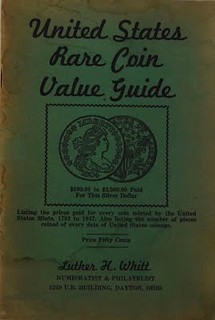 He joined the A.N.A. in May 1937 and became Member No. 6197. On his A.N.A. application he reported that his area of collecting specialization was "Emergency Money" and United
States coins. However, as we have seen, he was also a specialist in Lincolniana.
He joined the A.N.A. in May 1937 and became Member No. 6197. On his A.N.A. application he reported that his area of collecting specialization was "Emergency Money" and United
States coins. However, as we have seen, he was also a specialist in Lincolniana.
Whitt played an active role in promoting the A.N.A. in Dayton, Ohio and was a founding member of the Dayton Coin Club. He became the first secretary of the Club, a post he held through 1954. Their activities were reported in the October 1937 issue of The Numismatist.
In May 1939 the Dayton Coin Club held a public exhibition and Whitt exhibited "Lincoln in Numismatics and Philately".
On April 30, 1940 he held a coin auction sale with a four-page catalogue listing 414 lots.
In May 1954 he became the second Life Member of the Dayton Coin Club.
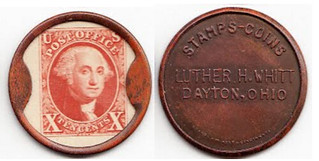 In September 1962, Whitt received a twenty-five year A.N.A. Silver Membership Award.
In September 1962, Whitt received a twenty-five year A.N.A. Silver Membership Award.
In 1968 he was elected Vic-president of the Ohio State Numismatic Society.
He died on June 22, 1977 at Arroyo Grande and is buried in the Arroyo Grande Cemetery, San Luis Obispo County, California.
To read the complete article, see:
WHITT, LUTHER HERBERT
(https://sites.google.com/a/numismaticmall.com/www/numismaticmall-com/whitt-luther-h)
DISPOSING OF THE LILLY COLLECTION
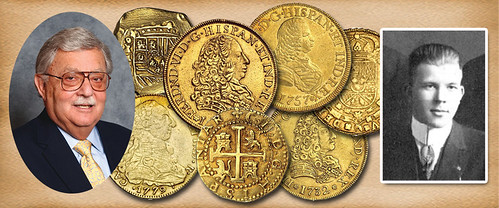
In early August of 1966, my cousin Norman Stack and I went to Indianapolis to work on the inventory. Norman had not seen all the coins we sold Mr. Lilly from 1951 to 1955 as he had been in the military stationed in Germany most of that time. Of course, when the collections were seen in total, it was amazing. Special black box after black box, each holding up to 144 gold coins, were brought into the large conference room at the bank, and we worked constantly for almost three full days. We had to verify the inventory, which would eventually be typed on a listing so that the appraisers and the bank had reference material. As noted, Norman had not seen much of the collection. He had never seen the sets of $1, $2.50, $3, and $4 gold, we got from the Anderson DuPont collections. He was aware of the Clifford Weihman $5 and $10 gold coins, but had not seen them for a decade or more when we had them at Stack's. And he had never seen the double eagles, a set that was also almost complete. The basic collection of pioneer and Territorial coins was also new for him to see. Of course, he was part of the team after 1955 and was aware of the items that had been acquired after that time. As a numismatist who understood the importance of completeness and quality, he was amazed at what Stack's and Mr. Lilly had been able to amass.
Using a file card system we developed for the Lilly collection, Norman and I spent several days checking off each coin. A few times they were out of order, or in another tray (the coins that measured over two inches in diameter did not fit in the standard trays). It was a revealing job for Norman and an exciting job for me. It was a wonderful opportunity to see once again the collection in total!
A few weeks after we visited the collection in the bank vault we had the inventory typed so it could be used by the appraisers for computing the total value of the collection. Hans Schulman and Abe Kosoff were the appraisers, following the suggestions we gave to Paul Rawley. With the information included in our inventory (including pedigree and source of acquisition) as well as our examination of each and every coin, the job of appraising was made somewhat easier for them. Yet, the appraisal by Kosoff and Schulman took longer than expected. Each took time to check and research each item; many were so rare that it took much time to find the reference material and check auction records. In some cases they had to go back a decade or more to provide the information required for the estate. About five months after we submitted the inventory, Kosoff and Schulman submitted their appraisals.
After his passing, and with the permission of Mr. Rawley, we were permitted to use the Lilly name in advertising. Before then, Stack's had kept the identity of Josiah K. Lilly a secret, as this is how Mr. Lilly wanted it. In the fall of 1966 we placed a series of ads that were worded like this:
“The secret that isn’t secret anymore! For 16 years (1951 to 1966) Stack’s was secretly building the most outstanding collection of United States, foreign and ancient gold coins ever assembled in the United States if not the world!
"It was formed by the late Josiah K. Lilly, who dedicated his collecting skills and avocation to forming a world class gold coin collection. Stack’s is proud that Mr. Josiah K. Lilly selected us to help him collect and develop this collection.”
After the ads appeared we received numerous calls about the final disposition of this superb collection. We responded that it would be determined later.
One of the calls came from curator of the Smithsonian National Numismatic Collection, Dr. Vladimir Clain-Stefanelli. He asked if we could get him an invitation to examine the collection and even to record the contents. He was invited to see it, and he did so, accompanied by his wife, Elvira, who was also a curator of the National Collection. They worked for several days, making notes and commenting that they had not known or heard of a collection of this scope and quality ever formed in the world.
Their basic opinion was that the collection was so extensive and of such great quality, scope and value, that it should not be broken up but should be kept together, possibly through it being acquired by the Smithsonian. Wow! This was a great compliment, but somewhat of a disappointment as we were hoping to be awarded the sale by auction. If the collection was not to be placed on the numismatic market, Stack’s would lose the possibility of selling it. It would be available for study, examination, and comparison by students and collectors. But, no collectors would be able to add pieces to their collections.
The question was: how would the government acquire this?
To read the complete articles, see:
Building a World Class Numismatic Gold Coin Collection The Josiah K. Lilly Collection Part 30
(http://www.stacksbowers.com/News/Pages/Blogs.aspx?ArticleID=2583)
Building a World Class Numismatic Gold Coin Collection The Josiah K. Lilly Collection Part 31
(http://www.stacksbowers.com/News/Pages/Blogs.aspx?ArticleID=2598)
To read the earlier E-Sylum article, see:
BUILDING THE LILLY COLLECTION, CONTINUED (http://www.coinbooks.org/v20/esylum_v20n23a15.html)

FAUNA: WILD ANIMAL ELONGATED CENTS
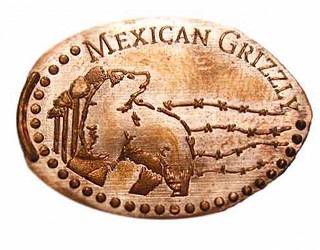 The fact that defaced currency (and the act of defacing it) has become associated with American tourist traps and other environments of manufactured fun is among the many miracles of late
capitalism. For a mere 51¢ (usually), the ubiquitous penny machine allows users to transform pocket change into a commemoration of their own passage through time and space. Once created primarily by
hijacking the force of bypassing trains, the smashed penny — or elongated, to numismatists and other serious folk — is now a relatively commonplace form of souvenir kitsch.
The fact that defaced currency (and the act of defacing it) has become associated with American tourist traps and other environments of manufactured fun is among the many miracles of late
capitalism. For a mere 51¢ (usually), the ubiquitous penny machine allows users to transform pocket change into a commemoration of their own passage through time and space. Once created primarily by
hijacking the force of bypassing trains, the smashed penny — or elongated, to numismatists and other serious folk — is now a relatively commonplace form of souvenir kitsch.
For roughly the past 10 years, Pittsburgh-based artists Stuart Anderson and Shaun Slifer have been devising a far more punk rock penny machine: Fauna. Finding common ground in their desire to work against dominant progress narratives, the pair have subverted the standard penny machine to invite ideological questions about the nature of industry, memory, and ecological destruction and adaptation.
Described by its progenitors as an “interactive kinetic sculpture,” the third and most current iteration of Fauna is a functional, built-from-scratch machine that presses two-sided pennies via a crank mechanism (a handsome ship’s wheel). For one side of the coin, users choose from nine either extinct or critically endangered animals, like the jaguar, red wolf, or passenger pigeon. Available for the flip side are nine sets of tracks, each representing a species of adapted urban wildlife, such as coyotes, raccoons, and groundhogs — what Anderson and Slifer referred to as “faunal weeds” in a recent telephone interview.
The initial concept for Fauna came from Slifer, who has collected souvenir elongated pennies for years. The project became reality by way of Anderson’s considerable mechanical abilities — constructing a hand-powered machine capable of repeatedly, accurately reproducing 81 possible image combinations, on metal, is no small task. Since the pair first met in 2003, Anderson has received his PhD in robotics from Carnegie Mellon, driven, he writes on his website, by an overarching fascination with the “turbulent boundaries between formal models and natural systems.” For Fauna, he innovated a set of two die carriages (modeled on the standard industrial rolling mill), each bearing three wheels of three designs each.
Though the 18 image options are original designs that Slifer solicited from fellow members of the Justseeds activist arts collective, Fauna is not intended to be shown at galleries. Instead, Slifer and Anderson hope to place the work within its “natural” setting of zoos and natural history museums — places “where people are already interacting with animals, either live or taxidermied,” Slifer said.
To read the complete article, see:
Smashing Pennies to Protest Industrial Capitalism
(https://hyperallergic.com/390319/smashing-pennies-to-protest-industrial-capitalism/)

Created by Stuart Anderson and Justseeds member Shaun Slifer, the Fauna penny press is an interactive kinetic sculpture that creates an experience designed to catalyze thought about the role of humans in the natural world. Fauna uses the human desire to identify with wild animals to present questions about how extinction alters our concept of nature, how adaptation drives our ecological future, and how an animal’s symbolic and cultural value can determine its survival.
 Participants use the machine to create double-sided pennies featuring embossed images selected from eighteen original illustrations (most by Justseeds members) of North American wild
animals. These durable images present critically endangered and extinct species on the face of the coin, and display the tracks of animals that have successfully adapted to the built human urban
environment on the back.
Participants use the machine to create double-sided pennies featuring embossed images selected from eighteen original illustrations (most by Justseeds members) of North American wild
animals. These durable images present critically endangered and extinct species on the face of the coin, and display the tracks of animals that have successfully adapted to the built human urban
environment on the back.
While the elongated penny originated in the 1890s, the practice of carrying coins as markers of identity, duty, or debt can be traced for thousands of years. The coins produced by Fauna give their bearers an opportunity to reflect on their personal relationship with wildness, extinction, and survival.
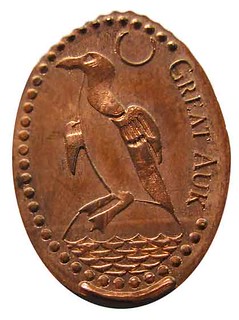

To read the complete article, see:
Fauna : A Penny Press (https://justseeds.org/project/fauna/)
PENNYBANDZ: WEAR YOUR SOUVENIR ELONGATED CENT
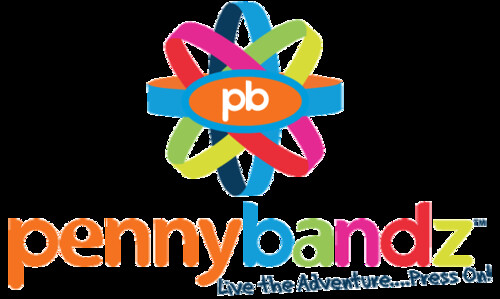
Innovation is alive in the coin field.
Native Texan Albert Guerro found a niche in the numismatic field and built a viable business with elongated cents. Or pressed pennies or smashed coins or whatever you wish to call them.
On a trip to Colorado, after his son had gathered half a dozen elongated cents, he wondered what to do with them now. Inspired he came up with the idea of a bracelet to contain one of the oval-shaped bronze souvenir discs.
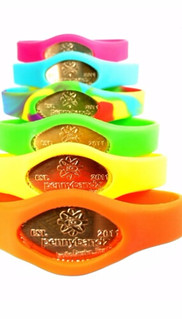 Development came slowly until he found a material the bracelets could be made of, a rubbery-like silicone. Also this could be made in different colors. He paid for molds and made some
samples. He was delighted an elongated cent fit perfectly well in the opening on top of the bracelet. It could be removed when a different specimen was selected to be shown. This was in the Fall of
2010 and his patent was granted in February 2011,
Development came slowly until he found a material the bracelets could be made of, a rubbery-like silicone. Also this could be made in different colors. He paid for molds and made some
samples. He was delighted an elongated cent fit perfectly well in the opening on top of the bracelet. It could be removed when a different specimen was selected to be shown. This was in the Fall of
2010 and his patent was granted in February 2011,
He placed an announcement on Facebook and sold enough to continue. He created a trademark of four overlapping ovals, and a brand name, Pennybandz, Ideas for a necklace and keytags prove successful as well. What else could he supply the elongated collector,? Albums to hold growing collections. He also sells a guitar pick under a different band name, Pickbandz.
Albert markets his wearable elongated cent products on Facebook, the internet and has an exclusive distributorship with CTM Group, The Penny Man, the firm that installs the rolling machines that you see everywhere\ Their rolling machine kiosks are in nearly 1,000 locations across America, national parks, museums, tourist attractions, amusement parks and such.
For more information on Albert’s products see:
http://pennybandz.com/store/c1/Featured_Products.html
Making Memories....Why Pennybandz?
We used to joke that we had enough money in pressed pennies to send our kids to college. We have always loved pressing a penny while on vacation or just a local outing. What a great and inexpensive
way to remember the day. When we returned home however, the penny ended up in the bottom of a drawer. We wanted a way to show off the penny and keep the happy memories of our adventure going. Even
more, we wanted a way to spark conversation about where we had been. Pennybandz is the answer. Live the Adventure…Press on!
THE BOOK BAZARRE
NUMISMATIC NUGGETS: JULY 16, 2017
c1888 Cambodia Pattern 1 Centime Brass Token
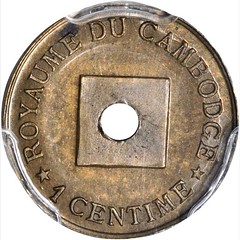
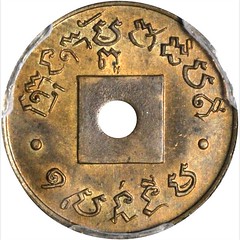
CAMBODIA. Pattern 1 Centime Brass Token, ND (ca. 1888). PCGS SP-65 Secure Holder. KM-Tn1; Gad-1 var.; Lec-1 var. 1.8 gms. Issued by the Royal Palace at Phnom Penh. The listed weight in Gadoury and LeCompte is 2 grams.
To read the complete lot description, see:
CAMBODIA. Pattern 1 Centime Brass Token, ND (ca. 1888). PCGS SP-65 Secure Holder.
(https://auctions.stacksbowers.com/lots/view/3-82YGB)
c1893 Ferracute Dogs Medal
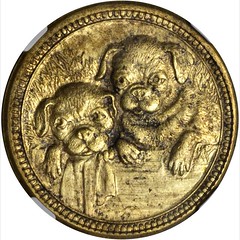

UNITED STATES OF AMERICA. Ferracute Dogs Medal, ND (1893). NGC MS-61.
Rulau-NJ-Brg-6. Struck in brass. Two puppies facing; Reverse: Coining press with legend around. The largest advertising/promotional token pieces struck by the Ferracute Machine Company who supplied
the machinery for and set up the Chengtu Mint in Szechuan and produced patterns and models for several of the denominations struck there.
To read the complete lot description, see:
UNITED STATES OF AMERICA. Ferracute Dogs Medal, ND (1893). (https://auctions.stacksbowers.com/lots/view/3-82UGJ)
Joan of Arc Medal By Blin
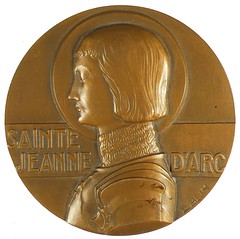
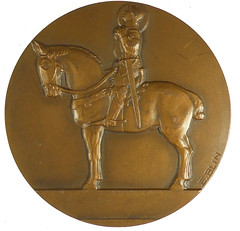
To read the complete lot description, see:
France religion SAINT JOAN OF ARC by Blin bronze 60mm (http://www.ebay.com/itm/152622797195)
1929 French Aviation Meal by Blin

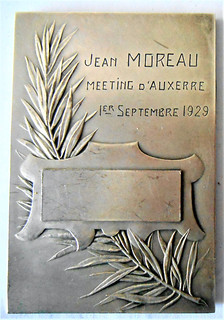
BEAUTIFUL FRENCH ORIGINAL ART DECO SILVER PLAQUE by EDOUARD-PIERRE BLIN
FOR THE CITY OF AUXERRE AERONAUTICAL MEETING 1929
LIGHT SCRATCH
EDGE MARK : LOSANGE -EAGLE'S HEAD -ARGENT
VERY RARE
67 X 41 MM / 82 GRAMS
WWI fighter squadron pilot
To read the complete lot description, see:
FRANCE-1929-AVIATION-EAGLES LOOKING AT A PLANE - SILVER ART DECO by BLIN
(http://www.ebay.com/itm/FRANCE-1929-AVIATION-EAGLES-LOOKING-AT-A-PLANE-SILVER-ART-DECO-by-BLIN/122463620260)
Georges Risler Family Medal by Poisson
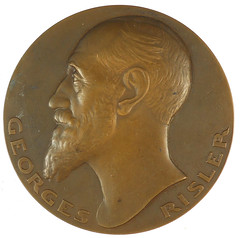
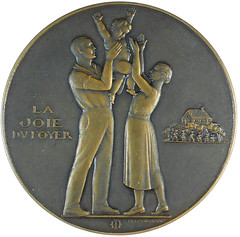
To read the complete lot description, see:
Family GEORGES RISLER Industrialist and Social Reformer by Poisson bronze 68mm (http://www.ebay.com/itm/152622864742)
To read the earlier E-Sylum article, see:
AMERICAN xxxxxxxx SOCIETY FITTER FAMILIES MEDALS (http://www.coinbooks.org/esylum_v19n18a21.html)
Coin-Embedded Lucite Toilet Seat
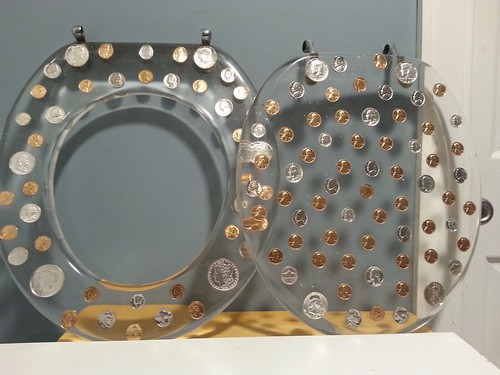
To read the complete lot description, see:
Toilet seat $9.00 face value silver 1901 Morgan 1922 Peace Franklin
1964 Kennedy (http://www.ebay.com/itm/Toilet-seat-9-00-face-value-silver-1901-Morgan-1922-Peace-Franklin-1964-Kennedy-/142190867287)
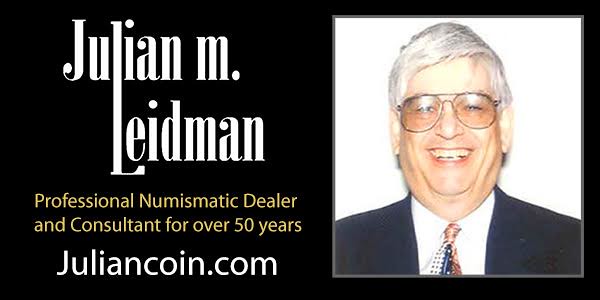
KELLEN HOARD'S 2017 ANA SUMMER SEMINAR REPORT
I was recently fortunate enough to attend both weeks of the American Numismatic Association’s Summer Seminar due to scholarships from the Pacific Northwest Numismatic Association (PNNA) and ANA. This event is an amazing opportunity to meet fellow numismatists young and old, take advantage of the ANA’s incredible resources, and learn from some of the hobby’s greatest minds!
On June 17, I flew from the Seattle-Tacoma International Airport to the Denver International Airport with my father; about a 3-hour flight. An additional one hour drive brought us to the ANA headquarters in Colorado Springs, directly across the street from Colorado College. After checking in, my father left (as he was staying in a hotel elsewhere in Colorado Springs), and I started taking in the sights and sounds of Summer Seminar. Four conversations resulted, including one with MPC-expert Fred Schwan. Dinner followed; the food was excellent, the cafeteria was clean, and the conversation was exhilarating.
Opening Ceremonies started at 6:00 PM, and helped to boost my personal excitement for the following days of instruction. Directly after the function came one of the most well-attended events at the entire Seminar: the book sale! Profits from the sale support the ANA library and provide any numismatist literally tons of information. One of my main specialties is numismatic literature, so I went into a personal nirvana upon entering the room full of books. One hour and many pounds of books later, I had lugged a box of books back to the Young Numismatist dorms. Here, most of the YNs slept, talked, and enjoyed each other’s company. That night at 10 PM, everyone staying in these dorm rooms attended a mandatory meeting. Finally, at midnight everyone went to bed.
The next day had a different format. Classes started at 9:00 AM sharp, and lasted until 11:45. Follow-up book sales occurred from 12:00 to 1:00, until classes restarted at 1:15. The first week I took a class called “Creating a Winning Numismatic Exhibit.” It was taught by award-winning exhibitor Larry Sekulich. Besides me (the only YN in this course), there were four other students. Some of the exhibit topics included $2 bills, how the evolution of the printing press affected coins, and my display on sample slabs. Each day, class ended at 4:00 PM, just in time for the third book sale; this time items were 25% off! That night I played cards and traded coins with fellow YNs, before attending the YN meeting and going to bed.
The next couple days followed a nearly identical format with a few exceptions. The afternoon book sale on Monday had a 50% discount, and the evening sale was just $5 per box! In total, I bought over 100 pounds of books in the first week. Additionally, Monday night was the YN Benefit Auction lot viewing. Each week, students can donate lots to be used in a “YN Auction.” This auction, created and run entirely by the YN at camp, creates funds for more Summer Seminar scholarships in the future. Tuesday was the day of the auction, and at 7:00 PM bidding started. At the end of the night over $10,000 was raised.
Soon, it was Wednesday; the final day of Summer Seminar. Classes continued as normal, but the afternoon session consisted of graduations. Certificates were handed out in class, and each student showed off what they had completed within their exhibit so far. At 5:00 PM, the graduation reception began. This was an opportunity for everyone at Summer Seminar to meet, talk, and enjoy some light snacks. Immediately afterwards, the graduation banquet took place. This was a two-hour long event full of delicious food, appreciation, and applause. At around 8:30, most of the YNs gathered on the field of the college and played a game of capture the flag until it was time to go inside. Once inside, it was time for a party; one of the most exciting parts of the day. YNs could stay up all night if we wish, and I stayed up until 2:45 AM before falling asleep out of exhaustion. The next day, my father and I shipped my books and drove to the Colorado Springs coin show which was happening nearby. We shortly left for a friend’s house north of Denver which we stayed at for the weekend in between Summer Seminar sessions.
Week 2 was nearly identical to Week 1, so I shall simply share the differences. First, I participated in a “Mini-Seminar.” These are two-day long classes at night. I took “Coin Shop Basics 101” conducted by the famous coin dealer Brian Fanton. Coincidentally, Fanton co-taught my class for week two: Grading Coins Part 1. The other instructors in my class were the ANA Education Director Rod Gillis and ANA Presidential Candidate Mike Ellis. This class taught me a considerable amount, and I was even named the student in class with the most potential! In the book sale, I bought about 30 pounds of books. Additionally, I participated in the YN Auction considerably more. I participated in lot donations, cataloging, running and recording, and lot viewing. Finally, on the final night the party lasted until 4:00 AM in the morning, leaving me exhausted the next day.
On Thursday, I finally left Summer Seminar. I had an amazing experience, but was ready to be home. A delayed plane resulted in a 7-hour wait at the airport. However, I arrived at Sea-Tac at around 8:00 PM and was home around 9:00.
I have highlighted all the items I am particularly excited about.
Auction Catalogs
- 1980, 1981, 1984, 1985, 1986, 1988, 1990, 1991, 1992, 1993, 1994, 1995, 1996 Young Numismatist Auction by ANA
- Catalogue of a Miscellaneous Collection of Coins and Medals Embracing Some Very Rare English Gold and Silver Specimens, of Great Value, and a Variety of American Coins and Medals, In Gold, Silver, Copper, Etc. by Bangs, Merwin, & Co. (December 28-29, 1863)
- Numismatic Literature First Fixed Price List by the Money Tree
- Mail Bid Sale #1: Selected Duplicated from the Armand Champa Library and Other Fine Consignments by Michael and Marlene Bourne (September 1, 1981 and signed by both)
- Catalogue of Important Numismatic Books Including The Fine Numismatic Library of the Late Kenneth W. Lee, Important Duplicates From the Armand Champa Library, and the Noteworthy Holdings of a Prominent Historical Institution by George Kolbe (June 12-13, 1981 with PR list)
- The Michael F. Higgy Collection: United States and Foreign Gold, Silver and Copper Coins by Abe Kosoff (PR List stapled in first page)
- The Frederick B. Taylor Collection by Bowers and Merena
- Elisaberg Collection Parts 1 and 2
- The Harry Bass Jr. Numismatic Library Part 4
- The John J. Ford Jr. Collection Parts 1-21 w/ Mail bid sheets
- The John J. Ford Jr. Reference Library Parts 1-2
- The Norweb Collection Parts 1-3
- Kolbe and Spink Joint Auctions: 1, 1, 4, 5, 7 (PR), 8, 9, 13, 14
- Kolbe Mail Bid: 8 (PR), 10, 45, 45, 60, 62, 67, 69 (Signed by Charles Moore)
- Kolbe: 7 (6/13/80-6/14/80), 14 (8/13/83 plus Prospectus), 21 (6/4/85 and 6/5/85 Plus Inscription to Remy Bourne from Cal Wilson with transcribed auction notes), 43 (2/2/90), 44 (6/1/90 Plus PR), 52 (10/17/92), 65/66 (6/1/96 and 6/5/96), 73 (6/13/98), 76 (12/15/98), 76 (12/15/98), 79 (11/13/99), 88 (6/14/02 Plus PR), 91 (6/19/03), 94 (10/14/04), 97 (9/29/05), 100 (6/3/06 P1), 100 (6/3/06 P2), 100 (6/3/06 P3), 100 (6/3/06 P4), 100 (Index), 103 (6/7/07), 104 (11/1/07)
- Kolbe Fixed Price List: 43
- Kolbe and Fanning: 119 (11/17/10)
- Davis Mail Bid: 18, 19, 20, 23, 26, 27, 4/17/89, 2/29/92 (Sklow receipt inside), 6/12/95, 2/24/96, 2/24/96, 9/28/96, 11/22/97,
- Davis: 3/22/97
- Sklow Mail Bid: 4, 5, 6, 7, 8, 8, 10, 11, 12, 13, 14, 15, 16, 17, 18, 19, 20, 21, 22, 23, 24, 25, 26,
- Swan Galleries: 1033 (Numismatic Literature from the Libraries of F.C.C. Boyd, T. James Clark, J. de Lagerberg, Wayte Raymond, and Other Sources) (8/30/76) (PR)
- The Amon G. Carter, Jr. Family Collection of United States Gold, Silver, and Copper Coins by Stacks
- The W.F. Dunham Collection by B. Max Mehl
Books
- United States Proof Coins 1936-1942 by Roger Burdette (Signed)
- A Treatise On The Coinage of the United States Branch Mints By A.G. Heaton (Inscribed on top “Compliments R.A. Webb 5/6/1936”) (1st edition without covers)
- A Guide Book of Civil War Tokens by Q. David Bowers
- A Guide Book of Hard Times Tokens by Q. David Bowers
- The Chinese Numismatic Riddle by Frank Higgins (Reprint)
- Select Numismatic Bibliography by Elvira Clain-Stefanelli
- Numismatic Bibliography by P.O. Sigler
- United States Pattern, Experimental, and Trial Pieces 6th Edition by J. Hewitt Judd
- Obsolete Paper Money Issues By Banks in the United States by Q. David Bowers
- So-Called Dollars by Harold Hibler and Charles Kappen
- The U.S. Mint and Coinage by Don Taxay
- Paper Money of the United States by Arthur and Ira Friedberg
- Medallic Portratis of Washington 2nd edition by Russell Rulau and George Fuld
- United States Gold Patterns by David Akers
- The United States Early Silver Dollars by M.H. Bolender
- Standard Catalog of United States Tokens by Russell Rulau
- 1943 Supplement to The Standard Paper Money Catalogue by Wayte Raymond
Periodicals
- The Bowers Review Issue #1
- Coin Trade Advertiser October 26, 1961
- Out on a Limb Volume 1 Number 1 and 2, Volume 2 Number 1-3, and Volume 3 Number 2
- The Asylum Volume I Number 1-4 Plus Index of The Asylum Volumes 1-10
- Empire Topics Issues 1-6 Library Edition by Empire Coin Company (Signed by Q. David Bowers)
- The Numismatist August, September, November 1942
- The Numismatist January-December 1943
- Numismatic Scrapbook Magazine 1940, 1941, 1942, 1943, 1946, 1947 (Bound, “Numismatic Shelf of H. Don Allen”)
- The Empire Review 14, 16, 18, 19
- The Bowers Review 2
Misc.
The Ancient Egyptian Scarab by Thomas Elder
- Educational Program for ANA’S 99th Anniversary Convention by ANA
- 1943 Chicago Coin Club Bulletin Annual Number
- Letter From John Jay Pittman To Ken Lowe about the 1990 Numismatic Bibliomania Society Meeting in Seattle and the Possibility of Remy Bourne and Armand Champa Speaking There
- Promotional Poster about the ANA Centennial History Three Book Set
- 1943 ANA Ballot
Also, Kellen has a question for E-Sylum readers - who was H. Don Allen? -Editor
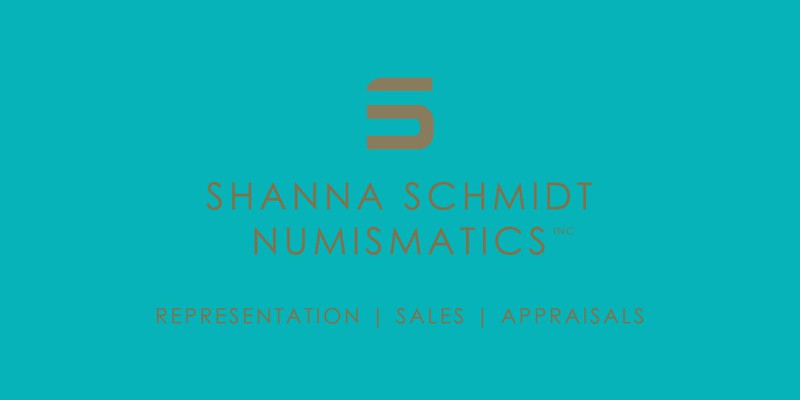
WAYNE'S NUMISMATIC DIARY: JULY 16, 2017
As noted in the book review elsewhere in this issue, I found myself with some time to kill before the July dinner of my Northern Virginia numismatic social group, Nummis Nova. It was Tuesday the 11th, and I found a table at a McDonald's near the restaurant where we'd soon meet.
 I'd brought with me a copy of the new book on Lesher dollars and managed to read a few chapters. Next I reparked my car in front of the restaurant, the Afghan Bistro. Jon Radel was our
host, and he'd made our reservation at the tiny place in a little strip mall off I-95.
I'd brought with me a copy of the new book on Lesher dollars and managed to read a few chapters. Next I reparked my car in front of the restaurant, the Afghan Bistro. Jon Radel was our
host, and he'd made our reservation at the tiny place in a little strip mall off I-95.
We were seated in a row of tables in front of a bench along the one wall. I ended up in the middle of the bench, kinda landlocked for the evening. To my left was Eric Schena and Jon was on my right. Other nearby earlybirds were Ron Abler, Joe Esposito, Dave Schenkman, Gene Brandenburg, and Gene's grandson Christian. Later Julian Leidman took at seat at that end.
Norman Rockwell Coin Collector Print
I spoke to Joe as I walked in. He was carrying this framed Norman Rockwell print he'd purchased some twenty years ago from the Armand Champa sale. It was still wrapped when I took this photo.
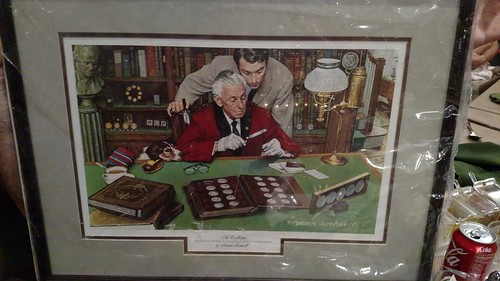
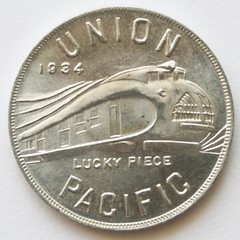 Dave Schenkman noticed our earlier reference to the 1930s Art Deco ALCOA Union Pacific aluminum token. As it happens, he has a small hoard of these and distributed one of the 1934-dated
varieties to everyone at the dinner. Thanks!
Dave Schenkman noticed our earlier reference to the 1930s Art Deco ALCOA Union Pacific aluminum token. As it happens, he has a small hoard of these and distributed one of the 1934-dated
varieties to everyone at the dinner. Thanks!
Zeppelin medal, Brockage Civil War Token
Among the next to arrive was Steve Bishop, who always seems to have some nice numismatic items to display. In addition to some nice Morgan dollars, he had a rare Civil War storecard and a great large
bronze plaque (about 7" across).

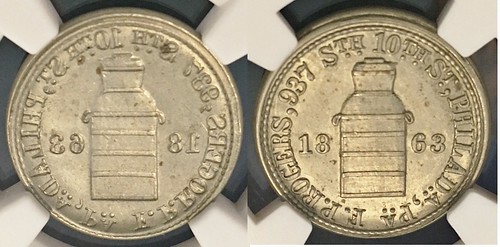
Steve writes:
The plaque was issued in 1925, and was the largest of the medals of this design issued. "FUR VERDIENSTE UM DIE ZEPPELIN ECKENER" translates to mean the medal was awarded for MERIT for the most generous donors to help fund the program to revive the manufacture of zeppelins.
The Civil War token is a first impression full brockage of a storecard for F.P. Grocers in Philadelphia.
Tom Kays, Chris Neuzil and Roger Burdette rounded out our group. Here are some photos.
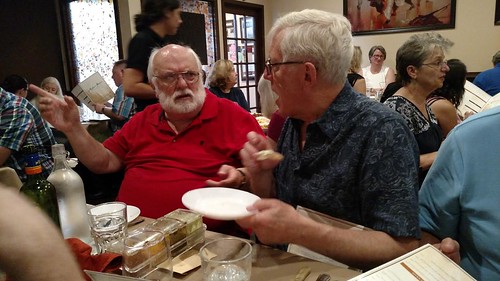
Gene Brandenburg and Dave Schenkman
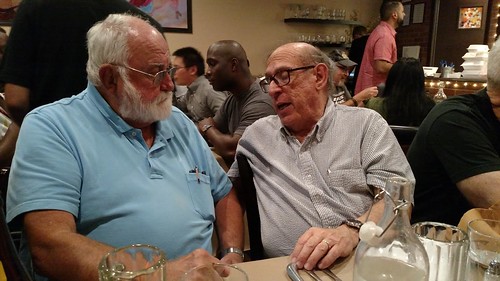
Ron Abler and Joe Esposito

The case held a variety of Canadian tokens from pre-Confederation days in honor of the recent 150th celebration this month. Upper Canada, Lower Canada, Newfoundland, Montreal, and New Brunswick were all represented by tokens from 1815 through 1864.
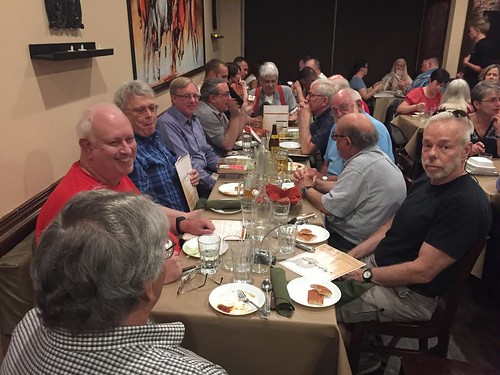
A group shot by Tom Kays, with Roger's back to camera
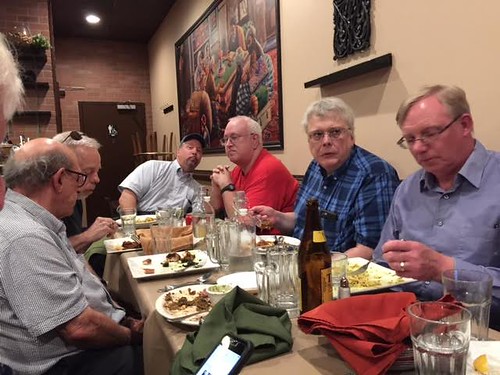
 These last two photos were provided by Gene. Above clockwise from the left are Joe Esposito, Chris Neuzil, Tom Kays, Steve Bishop, Jon Radel, and your truly, Wayne Homren. To the right is
Julian Leidman.
These last two photos were provided by Gene. Above clockwise from the left are Joe Esposito, Chris Neuzil, Tom Kays, Steve Bishop, Jon Radel, and your truly, Wayne Homren. To the right is
Julian Leidman.
Gene provides these captions:
"Tom Kays listing badly to one side."
"Julian's reaction after receiving a "sold item" email from eBay."
Gene adds:
Good restaurant, as close to authentic Afghan food as we're going to see - I suspect. Julian & I had the lamb, not to pull the wool over your eyes but not baaaad at all (sorry, couldn't resist).
Tom Kays writes:
At dinner we talked briefly about indexing more than coin books, static ephemera, or images for ease of searchability and universal access. Even beyond e-books, and websites with good numismatic content, new types of media are growing in importance to numismatists including streaming video from on-demand Podcasts, YouTube channels, and interactive iPhone apps that have specialized coin information, collector tools and interconnectivity to a great body of people in the coin business.
I “cut the cable,” and no longer receive digital over-the-air broadcasts deemed “appointment” television, and no longer see commercials, but get news, entertainment, and follow the exploits of real people - local stars, who carry Go-Pro cameras as they enjoy coin related hobbies, and who edit their exploits, and post the best of their sagas for free access. Using high-speed Internet, home sharing among household devices, wireless connectivity, and second-generation Apple TV, I see great content in high definition television, when I am ready to watch it.
By following these stars on Facebook or subscribing to their YouTube channels you get mobile notification of new episodes as they are posted. Agree/disagree with something they say, or want to ask them a question, and you can comment or post them email, and maybe help them with content for future episodes, as only television executives used to be able to do. Sounds good? Here is an example with excellent numismatic content that may be of interest, free for your enjoyment on your mobile phone, iPad, or television.
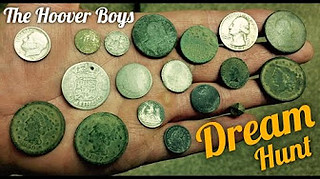 The Hoover Boys – On YouTube search for “The Hoover Boys” and find about 130 episodes of about 25 minutes length, posted since 2014, with their “channel” available for you to
subscribe to. Posted on Wednesdays, these videos follow a team of likeable guys, with Garrett metal detectors who go about saving history, one hole at a time. These videos maintain the excitement of
boys in the woods looking for treasure, who really do find fields of dreams.
The Hoover Boys – On YouTube search for “The Hoover Boys” and find about 130 episodes of about 25 minutes length, posted since 2014, with their “channel” available for you to
subscribe to. Posted on Wednesdays, these videos follow a team of likeable guys, with Garrett metal detectors who go about saving history, one hole at a time. These videos maintain the excitement of
boys in the woods looking for treasure, who really do find fields of dreams.
Based in Maryland, but ranging about the mid-Atlantic states, Kurt Franz, a fireman on weekdays, becomes a bit of an “Eastern Shore Indiana Jones” on weekends with a steady crew of friends, Brad, Bob, and others who go knocking on old farmhouse doors, seeking permission to detect plowed fields with the land-owner’s permission, eating their lunch, and saving real bits of American history as you tag along, seeing highlights of dawn-to-dark weekend digging without incurring sweat, sunburn, chiggers, and aching backs.
Best is their focus on coins in every episode, colonial and early Federal coins especially, with live digs that often go “bazinga,” in-situ views of what they find, in-the-field tentative IDs with the help of “Foo-Foo Juice,” follow-up numismatic research, with immediate cut-away to after-the-fact images of the coins cleaned up and identified by type, date range, and hopefully exact date, mint mark, scarcity and history.
The boys don’t take each other seriously, which makes their banter funny, but they do revere the history of the coins and objects they find. These videos are the best among the YouTube treasure hunting genre, due to excellent camera work by Kurt, with in-focus close-ups, honest never-seeded digs, steady commentary, quick timing, good story-telling, and bloopers. They all end with a final, back-of-the-pick-up truck review, showing the day’s junk and gems of numismatic excellence, true results of long but happy days digging, by an experienced group of friends, who walk some of the best and earliest sites the East Coast offers.
They disdain 20th century common coins and keep looking until the early stuff comes to light. Elizabethan hammered, Georgian coppers, Spanish silver pistareens, pillars and portraits, colonial State coppers, and early Federal coins and tokens with Liberty Caps, Draped Busts, Small Eagles, Seated Liberties, unknown mystery pieces, and even key dates come to light in good numbers, alongside other period artifacts of the past.
Stay tuned. No telling what numismatic treasures will be found this week, on the Hoover Boys. As Kurt Franz says, “Help clean up the ground, dig it all, and take your trash with ya’...Why?…Because all holes matter.”
To view the Hoover Boys videos on YouTube, see: The Hoover Boys (https://www.youtube.com/channel/UCc2EIdDCpheoPTr-E6e8GZg)

CRIME WINE: COUNTERFEITING THE COPPER COIN
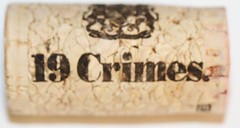
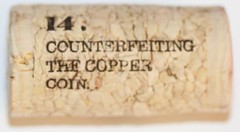
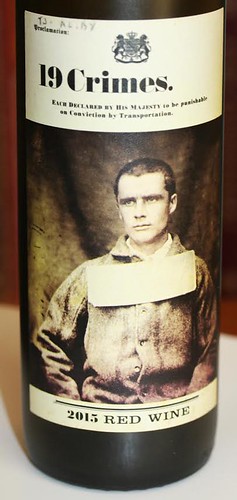 Saturday Joanne and I spent an enjoyable evening at Gene and Amelia Brandenburg’s home, joined by their grandson, Christian, and Joe and Hope Esposito. Gene had a new Australian red wine
for us to try: 19 Crimes, “Each declared by His Majesty to be punishable on conviction by transportation.” The label on the back of the bottle explained that
Saturday Joanne and I spent an enjoyable evening at Gene and Amelia Brandenburg’s home, joined by their grandson, Christian, and Joe and Hope Esposito. Gene had a new Australian red wine
for us to try: 19 Crimes, “Each declared by His Majesty to be punishable on conviction by transportation.” The label on the back of the bottle explained that
“Nineteen Crimes turned criminals into colonists. Upon conviction, British rogues, guilty of at least one of the 19 crimes, were sentenced to live in Australia, rather than death. This punishment by “transportation” began in 1788, and many of the lawless died at sea. For the rough-hewn prisoners who made it to shore, a new world awaited. As pioneers in a frontier penal colony, they forged a new country and new lives, brick by brick. This wine celebrates the rules they broke and the culture they built.”
This is well and good, but what were those 19 crimes? As the evening went on, we learned more about them, because one is listed on each cork. For example, number 10 is “stealing fish from a pond or river,” while number 7 is “setting fire to underwood.”
Since there is no way to know what crime is mentioned a cork, we wondered how many bottles one would need to open to get a full set of nineteen. Fortunately, the first bottle Gene opened was the numismatic key to the set. It had crime number 14, “counterfeiting the copper coin.”
The ribs and salads were really great, but I’ll probably remember the wine longer.
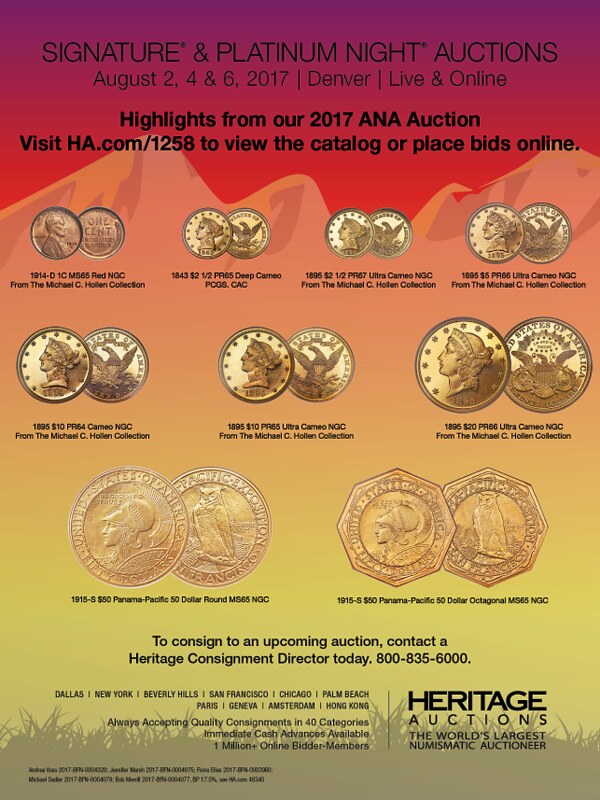
MORE ON THE VICTOR ADDA COLLECTION
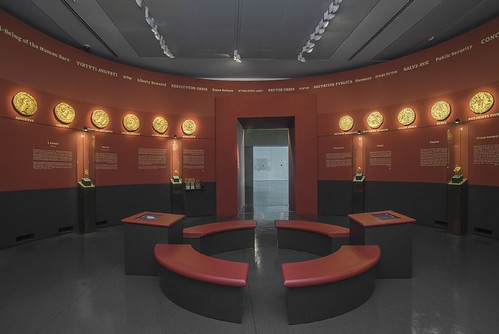
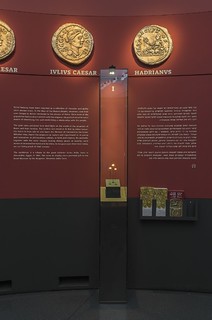
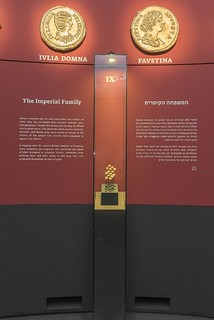
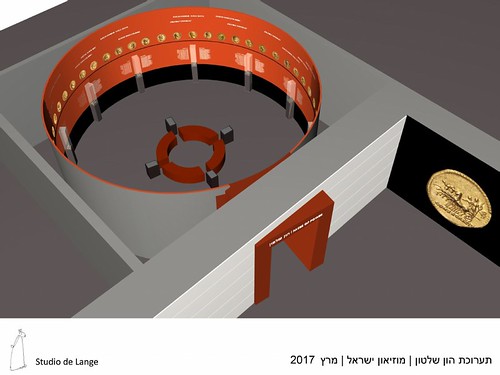
To read the complete article, see:
https://www.academia.edu/33881062/http_www.imj.org.il_en_exhibitions_faces-power
To read the earlier E-Sylum article, see:
EXHIBIT: THE VICTOR ADDA COLLECTION (http://www.coinbooks.org/v20/esylum_v20n26a21.html)
ROMAN COIN HOARD AT SPANISH MINING SITE
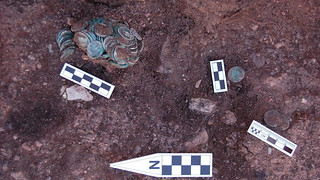 A treasure of gold and silver ancient Roman coins has been found at a mining site in Huelva, southern Spain.
A treasure of gold and silver ancient Roman coins has been found at a mining site in Huelva, southern Spain.
The discovery is of "incalculable value and a milestone in the archaeology of this mining area," according to the archaeologists from Atalaya Mining, the company running the mine who found it. The discovery was reported by local newspaper Huelva Informacion.
The 40 or 50 coins found, which date from the 2nd century AD, according to a report in La Informacion, are said to be from the era of Nero and Trajan.
"It is a discovery of great beauty that comes to contribute data to our knowledge of RioTinto, that was the great mine of the Roman Empire," Luis Iglesias, director of archaeology at Atalaya Mining, told El Pais.
Experts believe the owner of the coins would have been an influential resident of the ancient Roman settlement of Orium. The coins were found bunched together because they would probably have been held in a leather purse before, according to the archaeologists who found them.
To read the complete article, see:
Roman coin hoard found at Spanish mining site
(https://archaeologynewsnetwork.blogspot.com/2017/07/roman-coin-hoard-found-at-spanish.html#RjQ1TTai7ikPEDM6.97)
MEDIEVAL TALLY STICKS AND HOW THEY WORKED
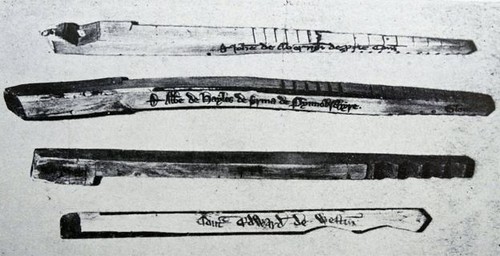
[A]s Felix Martin points out in his book, Money: The Unauthorised Biography, that most of our monetary history hasn't survived in a form that could grace a museum.
In fact, in 1834, the British government decided to destroy 600 years of precious monetary artefacts. It was a decision that was to have unfortunate consequences in more ways than one.
The artefacts in question were humble sticks of willow, about eight inches (20cm) long, called Exchequer tallies. The willow was harvested along the banks of the Thames, not far from the Palace of Westminster in central London.
Tallies were a way of recording debts with a system that was sublimely simple and effective.
The stick would contain a record of the debt, for example: "£9 4s 4d from Fulk Basset for the farm of Wycombe". Fulk Basset was a Bishop of London in the 13th Century. He owed his debt to King Henry III.
Now comes the elegant part.
The stick would be split in half, down its length from one end to the other. The debtor would retain half, called the "foil". The creditor would retain the other half, called the "stock" - even today, British bankers use the word "stocks" to refer to debts of the British government.
Because willow has a natural and distinctive grain, the two halves would match only each other.
Of course, the Treasury could simply have kept a record of these transactions in a ledger somewhere. But the tally stick system enabled something radical to occur.
If you had a tally stock showing that Bishop Basset owed you £5, then unless you worried that he wasn't good for the money, the tally stock itself was worth close to £5 in its own right. If you wanted to buy something, you might well find that the seller would be pleased to accept the tally stock as a safe and convenient form of payment.
So the tally sticks themselves became a kind of money, a particular sort of debt that could be traded freely, circulating from person to person until it utterly separated from Bishop Basset and a farm in Wycombe.
To read the complete article, see:
What tally sticks tell us about how money works (http://www.bbc.com/news/business-40189959)

Notched pieces of wood or bone were used by many ancient peoples to record numbers. The most common type of these “tally sticks” was made of wood. Tally sticks served as records or receipts for financial transactions such as the payment of taxes, debts and fines. From the 12th century onward tally sticks were officially employed by the Exchequer of England to collect the King’s taxes. Local sheriffs were given the task of actually collecting the taxes. The depth and series of notches on these sticks represented the value of the transaction. In recording a debt, a wooden stick was often split horizontally into two parts: the lender receiving one part, the stock; and the debtor, the other part, the foil. This box contains sticks that date from the year 1296 and were found in the Chapel of the Pyx, Westminster Abbey in 1808. England abolished the use of tally sticks in 1826. The accumulation of tally sticks in the Office of the Exchequer were burned in 1834 resulting in a fire that destroyed the Parliament Building.
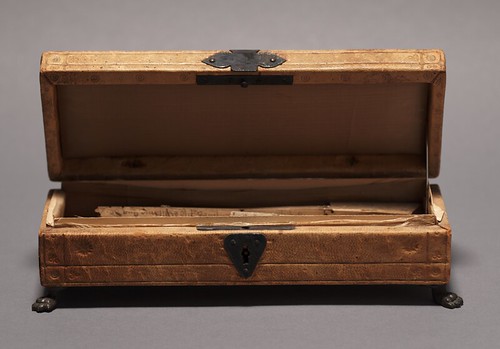
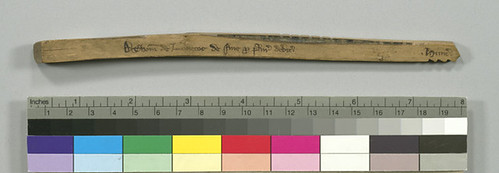
To read the complete article, see:
Mathematical Treasures - English tally sticks
(https://www.maa.org/press/periodicals/convergence/mathematical-treasures-english-tally-sticks)
To read the earlier E-Sylum articles, see:
FEATURED WEB SITE (http://www.coinbooks.org/esylum_v03n29a13.html)
WAYNE'S LONDON DIARY 7 SEPTEMBER, 2007: THE BANK OF ENGLAND MUSEUM (http://www.coinbooks.org/esylum_v10n36a11.html)
BOOK REVIEW: MONEY: THE UNAUTHORISED BIOGRAPHY (http://www.coinbooks.org/esylum_v16n27a08.html)
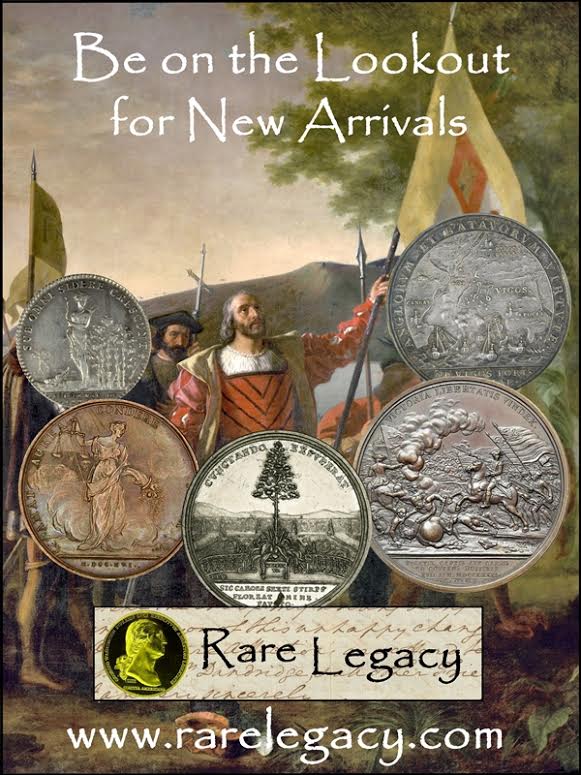
COIN CELEBRATES ORDER OF CANADA MEDAL
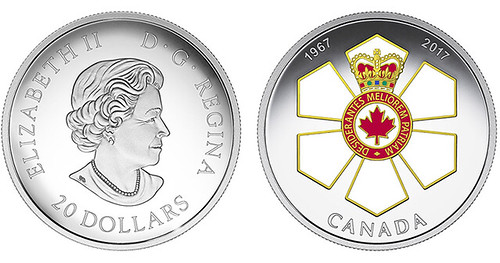
The Royal Canadian Mint have issued a new coin which celebrates Canada’s highest civilian award, the Order of Canada. Since 1967—the year of its creation, which was the centennial anniversary of Canadian confederation—more than 6,000 people from all sectors of Canadian society have been recognised for their unique contributions that have made their country a nation of service, innovation, and excellence. These distinguished citizens are the members of one of Canada’s most prestigious fellowships. The Order of Canada is the country’s badge of honour for outstanding achievement, dedication, and merit, as reflected in the order’s motto, “Desiderantes meliorem patriam” (They desire a better country). By virtue of their membership and rank, each has the right to wear this exclusive insignia.
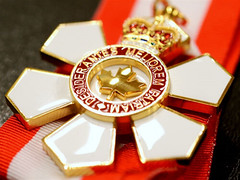 Prior to 1967, Canada did not have an honours system of its own, and deserving Canadians were typically recognised with British honours, with the exception of a select few Canadian medals.
In 1867, the year of Canadian confederation, the first governor general of Canada, the Viscount Monck, introduced the idea of a Canadian honours system by proposing an order of knighthood called the
Order of St. Lawrence. The idea of home-grown honours was periodically revisited throughout the late 19th and early 20th centuries; but in 1966, the idea finally came to fruition when the concept was
championed by Prime Minister Lester B. Pearson to coincide with Canada’s centennial celebrations.
Prior to 1967, Canada did not have an honours system of its own, and deserving Canadians were typically recognised with British honours, with the exception of a select few Canadian medals.
In 1867, the year of Canadian confederation, the first governor general of Canada, the Viscount Monck, introduced the idea of a Canadian honours system by proposing an order of knighthood called the
Order of St. Lawrence. The idea of home-grown honours was periodically revisited throughout the late 19th and early 20th centuries; but in 1966, the idea finally came to fruition when the concept was
championed by Prime Minister Lester B. Pearson to coincide with Canada’s centennial celebrations.
The coin’s reverse is a faithful depiction of the actual Order, recreating the six symmetrical points that lead to an annulus at the centre, where a red maple leaf indicates the Companion rank. The order’s motto, DESIDERANTES MELIOREM PATRIAM, is circumscribed around Canada’s beloved national symbol, which is surmounted by the royal crown. The double years of 1967 and 2017 above the motif are included to represent the 50th anniversary of the Order of Canada. The application of colour on this numismatic piece also recreates the complex and colourful enamelling of the iconic insignia.
The obverse features the effigy of Her Majesty Queen Elizabeth II which was created by Susanna Blunt and has been in use on all Canadian circulation and many commemorative coins since 2003.
To read the complete article, see:
Canada: Order of Canada civilian award celebrates 50 years with elegant
new silver coin (http://news.coinupdate.com/canada-order-of-canada-civilian-award-celebrates-50-years-with-elegant-new-silver-coin/)
CANADIAN DOLLAR DESIGNER KLASSEN MEETS PUBLIC
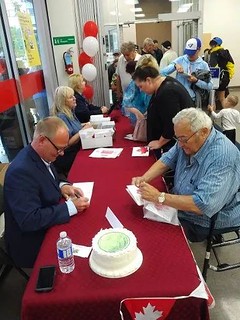
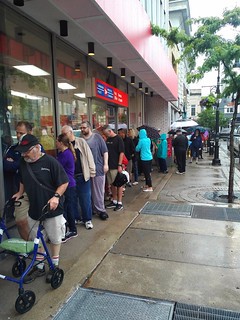
Neither rain, nor sleet, nor snow can keep coin collectors away from the post office, it seems, not when there is a chance to meet the creator of a new loonie.
Hundreds of collectors, young and old, patiently waited in the rain outside of the Queen Street Canada Post office Thursday for the chance to shake hands with local artist Wesley Klassen, whose artwork is the new face of Canada’s dollar coin.
“It’s a celebration of Canada,” said St. Catharines coin collector Ben Corfield, taking shelter under the post office’s awning. He has been collecting coins since he was a boy, he said and wasn’t going to miss the chance at meeting someone who designed the face of a loonie.
“It’s just a great thing to me to see so many people excited about the good things Canada does.”
Post office staff told The Standard people began lining up two hours before the doors opened.
Coin collectors and the curious arrived at a steady pace, keeping the line long enough to reach the intersection with St. Paul Street most of the day. Those who didn’t have the new loonie could exchange as many as three of their old coins for a new one.
Inside, Klassen was all smiles. The St. Catharines artist, an electrician with Ontario Power Generation, was at the post office as part of a promotional event to highlight the coin produced for Canada’s 150th anniversary.
He said he was overwhelmed by the long line of people waiting to see him.
“I did two of these the other day at post offices in Hamilton, and I got the first taste of this. A lot of people showing up and expressing their appreciation. It is a little unexpected, but I am very appreciative,” said Klassen.
Klassen’s design, which features a train, fishing boats, a lighthouse and Peggy’s Cove, Chateau Frontenac, the CN Tower, Prairie grain elevators and Lions’ Gate Bridge in B.C., was chosen for the loonie after a national contest that saw more than 10,000 Canadians submit entries.
He said he was trying to tell the story of Canadian achievement in a single image. It started with the train to represent the rail line that connects the nation coast-to-coast and evolved from there.
“One of the special things about it for me is that all of the places featured on the coin are places my parents took me to as a child,” Klassen said.
Klassen has no formal art training but learned the craft of pictorial storytelling from his father John Klassen, a successful amateur artist in his own right who designed the original coat of arms for the Town of Niagara-on-the-Lake.
To read the complete article, see:
Hundreds brave rain to meet coin artist
(http://www.stcatharinesstandard.ca/2017/07/13/hundreds-brave-rain-to-meet-coin-artist)
To read the earlier E-Sylum articles, see:
ARTIST WESLEY KLASSEN SUBMITS DESIGNS FOR CANADIAN COINS (http://www.coinbooks.org/esylum_v18n36a33.html)
CANADA'S SESQUICENTENNIAL CIRCULATING COINS (http://www.coinbooks.org/esylum_v19n45a20.html)
THE BOOK BAZARRE
UK AQUATICS OLYMPIC 50P SETS PRICE RECORD
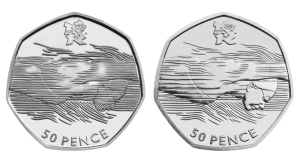
Finding a coin which is worth a small fortune is the stuff of dreams for every Change Checker. You may remember the excitement over the rarity of the Kew Gardens 50p earlier this year and the bidding frenzy that occurred on eBay shortly afterwards.
Well now there is a coin which has eclipsed the Kew Gardens, both in terms of scarcity, and the sheer scale of money changing hands.
This week, a UK 50 pence piece sold on eBay for £820. Or to put it another way, 1,640 times its face value!
It appears to be an ordinary Aquatics Olympic 50p at first glance, but this coin has a special quality which collectors desire more than anything else: an error.
In 2011 the Aquatics Olympic 50p depicting a swimmer underwater was redesigned by the Royal Mint to make the swimmer’s face more visible. However, before the change was made, a small number of coins were struck with the original design.
The added sense of excitement and anticipation over this particular error is that nobody knows exactly how many of the original coins were ever struck.
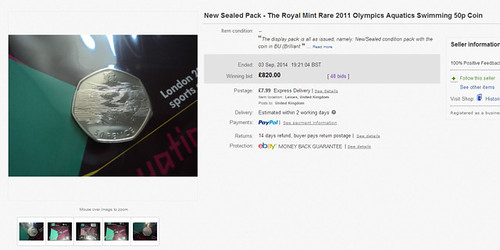
Their rare appearance at auction (and only so far in their original packaging) along with the astronomical amounts which buyers are happy to pay, supports the theory that there are very few around.
The 29 Olympic designs are now commonplace in our day-to-day life, so this coin ultimately is just a normal 50p which you would happily pass over the counter to pay for something. Blink and you would miss that small detail which is worth so much to coin collectors.
To read the complete article, see:
This 50p just sold for £820.00 (https://blog.changechecker.org/2014/09/05/this-50p-just-sold-for-820-00/)
ISLAMIC STATE CURRENCY DESIGNER REPORTED KILLED
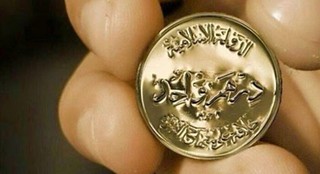 Islamic State’s currency designer was killed Sunday by unknown attackers west of Mosul as security forces chase the last few remaining militants in the region.
Islamic State’s currency designer was killed Sunday by unknown attackers west of Mosul as security forces chase the last few remaining militants in the region.
A local source told Alsumaria News that the militant carried the nationality of a “neighboring country”, and was killed in central Tal Afar, a major IS stronghold west of Mosul. He was on his way out of a home which he had seized, the source revealed.
The targeted member was one of a few foreign nationals which the Islamic State had tasked with designing the group’s golden currency as part of the so-called “treasury department”.
The assassinated member was a close aide to IS supreme leader Abu Bakr al-Baghdadi, said the source.
Despite its shrinking domain under security operations, Islamic State ordered merchants to adopt its golden Dirham and Dinars starting 27th of the last month, setting their values at USD 1.80.
Iraqi government forces, backed by a U.S.-led coalition and paramilitary forces, are currently fighting IS members out of the last few meters in Mosul, their previously-proclaimed capital.
To read the complete article, see:
Islamic State currency designer killed in anonymous attack west of Mosul
(http://www.iraqinews.com/iraq-war/islamic-state-currency-designer-killed-anonymous-attack-west-mosul/)
SHILLING BANKNOTE CENTER OF SOMALI CONFLICT
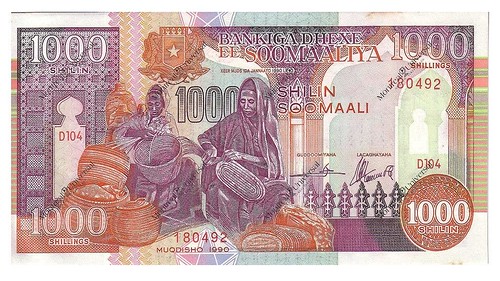
After Islamist group al Shabaab’s ban on the Somali Shilling in the central and southern regions under its control over alleged influx of fake notes, some traders are reported to have resorted to the use of Ethiopian Birr.
According to a report by Somalia’s Dalsan Radio in Mogadishu, traders in Galmudug are using the Ethiopian currency in respect of the instructions.
Business in the central Somalia’s region of Hiiraan also stalled last week following the ban of the 1000 Shilling banknote which is the only Somali currency in circulation.
The order follows reports that the semi-autonomous state of Puntland had printed and circulated counterfeit banknotes to float the exchange rate between the dollar and shilling.
The Puntland authorities responded to the allegations and ban in a statement saying the militant group wants to “devalue the Somali shilling and empowering the foreign currency”.
“Puntland government warns business owners in Puntland against following the ban on the Somali shillings. Anybody found complying Al-Shabaab ban will be considered as a member of them and will face consequences,” the statement cited by local media said.
Some residents are reported to have staged protests outside shops over refusal to accept the Shilling.
Puntland is partly under the control of al Shabaab.
To read the complete article, see:
Somali traders heed to Al Shabaab ban on local currency, use Ethiopian
Birr (http://www.africanews.com/2017/07/14/somali-traders-heed-to-al-shabaab-ban-on-local-currency-use-ethiopian-birr/)

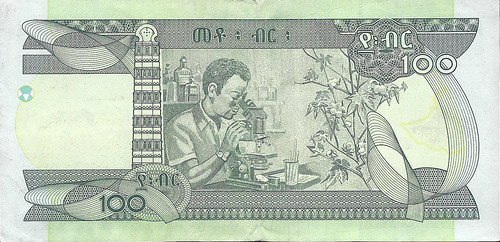
For more information on The Banknote Book, see:
http://www.banknotenews.com/banknote_book/banknote_book.php
THE DAY KENYANS DUG OUT THEIR CASH
August 1965 marks one of the most peculiar incidents in Kenya’s banking history. This is after Barclays Bank set foot in Lamu Island. As soon as the bank opened, residents rushed for their spades and started digging out their savings from pits underneath their homes. For centuries, the people of Lamu had been cut off from the mainland mainly by floods and had resorted to burying their money or stuffing it under their bedding, wrote the East African Standard (now The Standard).
Barclays was the first bank to dock there. “Out come Lamu’s savings,” screamed a headline on the August 6, 1965 edition. That day, clerks must have hurt their backs, because according to the paper, “a steady stream of people” kept them busy by depositing amounts ranging from a few shillings to several pounds. The area District Commissioner B.A Osundwa described it as one of the biggest phenomena to ever occur on the island, pointing out that some people were still in possession of old Abyssinian coins.
“There are even people on the island still hoarding the old Abyssinian Thalers (old silver coin currency) because they haven’t been able to bank them in the past,” he was quoted as saying.
Another unusual incident had also occurred in Northern Africa after the opening of a Barclays Bank branch. A herdsman turned up at the bank one morning with a sheared sheep to submit a strange cheque. On the sheep’s back he had written ‘cheque’ and astonishingly it was honoured. This peculiar case was being reminded to Mr J.B.K Russel, a Barclays Executive from Nairobi, by Somali tribesmen who had travelled to Garissa to witness the opening of the first Barclays branch office in North Eastern Kenya as captured in the East African Standard. This was in March 1965. Before then, money had to be flown in from Nairobi and would sometimes be collected by road from Thika.
To read the complete article, see:
The day Kenyans dug out cash to receive first bank
(https://www.standardmedia.co.ke/business/article/2001247009/the-day-kenyans-dug-out-cash-to-receive-first-bank)
MUSEUM OF THE RIVERINA EXHIBIT EXAMINES MONEY
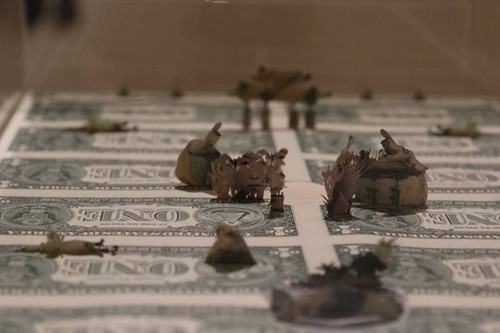
Cutouts of Japanese notes rise over a landscape of American money
ALTERNATIVE banknotes, old mechanical adding machines, and love tokens inscribed by convicts are just some of the curiosities on display in Creative Accounting, a new exhibition that explores the value of money.
The archival objects sit alongside a selection of works by Australian and international contemporary artists. In a time when it’s possible to receive, and then spend an entire pay packet without physically handling a note or coin, Creative Accounting asks questions about money’s enigmatic nature.
Alternative banknote designs raise questions about sovereignty and power, while intricate cash origami draws attention to the aesthetic and ephemeral aspects of currency.
What do concepts such as value, ownership, conquest and indebtedness mean in a world where transactions are virtual? How can government plans or foreign policies have substance when the fates of millions rest on the behaviour of tiny digits on flashing boards in a stock exchange?
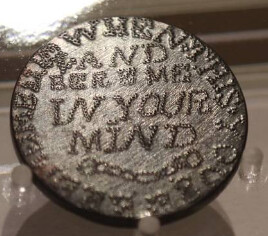 Creative Accounting also showcases into some very local examples of the world of finance. Architectural plans of the original Wagga branch of the Bank of NSW (now Farrell Lusher Solicitors,
corner Fitzmaurice and Johnston streets) show how it was common practice in those days for a bank manager live directly above his branch.
Creative Accounting also showcases into some very local examples of the world of finance. Architectural plans of the original Wagga branch of the Bank of NSW (now Farrell Lusher Solicitors,
corner Fitzmaurice and Johnston streets) show how it was common practice in those days for a bank manager live directly above his branch.
This accessible and thought-provoking exhibition will delight all ages and is on exhibition at the Museum's Historic Council Chambers site until October 8, 2017.
To read the complete article, see:
At the museum, July 15, 2017 (http://www.dailyadvertiser.com.au/story/4787740/citys-got-a-love-of-money/)
VISA LURES MERCHANTS TO GO CASHLESS
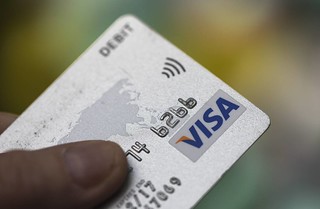 Visa Inc. has a new offer for small merchants: take thousands of dollars from the card giant to upgrade their payment technology. In return, the businesses must stop accepting cash.
Visa Inc. has a new offer for small merchants: take thousands of dollars from the card giant to upgrade their payment technology. In return, the businesses must stop accepting cash.
The company unveiled the initiative on Wednesday as part of a broader effort to steer Americans away from using old-fashioned paper money. Visa says it is planning to give $10,000 apiece to up to 50 restaurants and food vendors to pay for their technology and marketing costs, as long as the businesses pledge to start what Visa executive Jack Forestell calls a “journey to cashless.”
“We’re really viewing this as the opening salvo,” said Mr. Forestell, Visa’s global head of merchant solutions, of the potential total $500,000 commitment.
Consumers at those stores would be able to pay for goods or services only with debit or credit cards or with their cellphones. In exchange, Visa is offering to pay for upgrades to merchants’ technology at the checkout line so that they can accept contactless payments, such as Apple Pay . The $10,000 incentive can also help cover some of the merchants’ marketing expenses.
Visa will pick the participating merchants from an application process that starts in August. Online-only shops are excluded.
Visa has long considered cash one of its biggest competitors and has been taking steps to chip away at it. Getting rid of cash is a priority for Visa Chief Executive Al Kelly, who took over late last year, especially as cash and check transactions continue to grow globally.
“We’re focused on putting cash out of business,” Mr. Kelly said at Visa’s investor day last month, adding that converting check and cash to digital and electronic payments is the company’s “number-one growth lever.”
Some merchants have already stopped taking cash. New York City-based 2nd City, a Filipino taqueria, hasn’t accepted cash since it opened its doors in 2016. Michael Ryan, the co-owner and co-founder, said he never ordered cash drawers or a safe. By not having to count cash, visit a bank or order change, Mr. Ryan estimates, the manager on duty saves about 23 hours a week.
The restaurant, which mostly caters to millennials, has had “very little” push back from customers, Mr. Ryan said. He added that the downside is the fees that his business pays to the card issuers.
Indeed, many merchants prefer cash because they don’t have to share the revenue with card companies. Credit-card interchange fees, which networks like Visa set and that merchants pay to the banks that issue their cards, are on average around 2% of the transaction amount, according to the National Retail Federation, the largest trade group that represents merchants in the U.S.
“The idea that merchants don’t want to accept cash is a myth,” said Mallory Duncan, senior vice president and general counsel at the National Retail Federation.
To read the complete article (subscription required), see:
Visa Takes War on Cash to Restaurants
(https://www.wsj.com/articles/visa-takes-war-on-cash-to-restaurants-1499853601)

